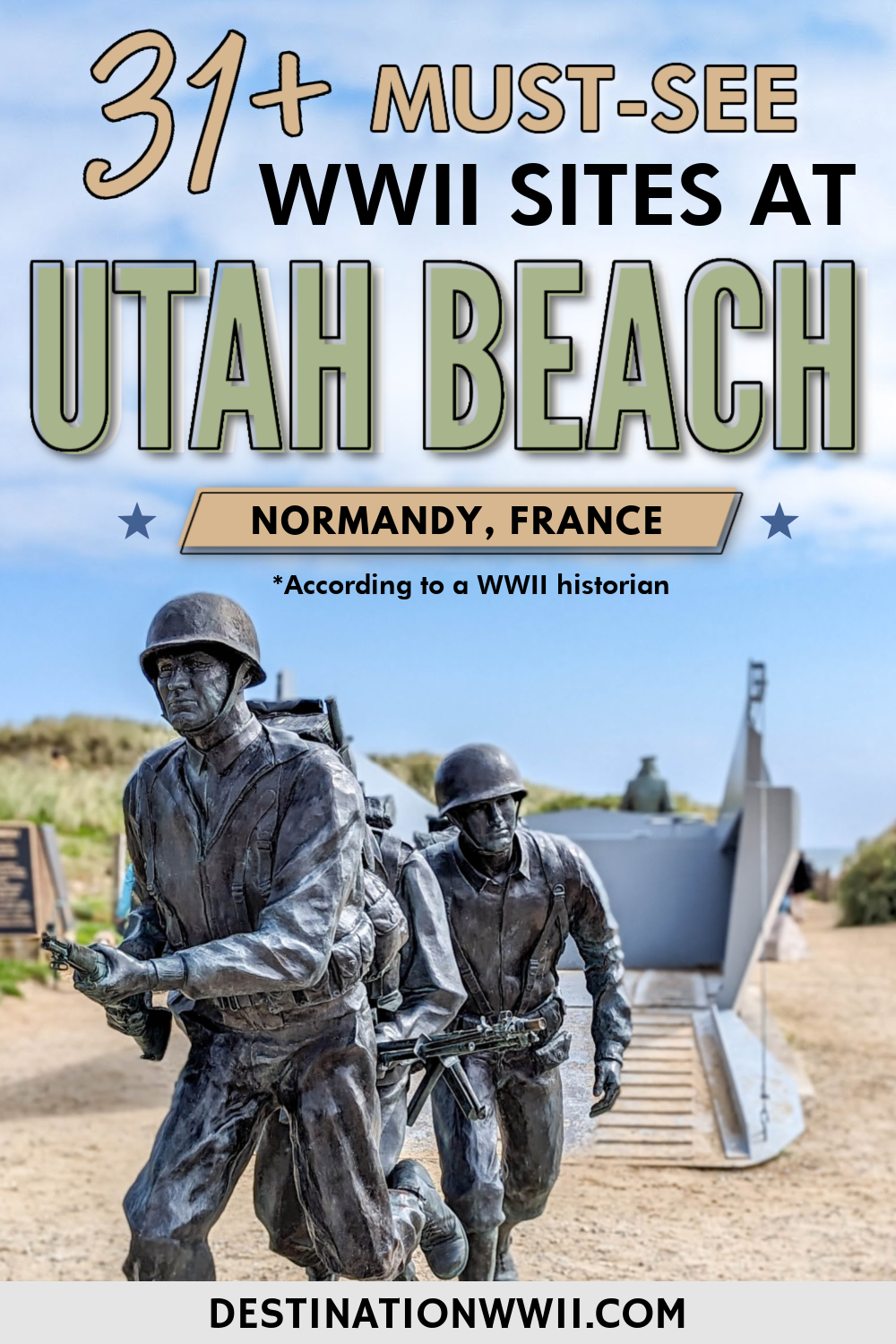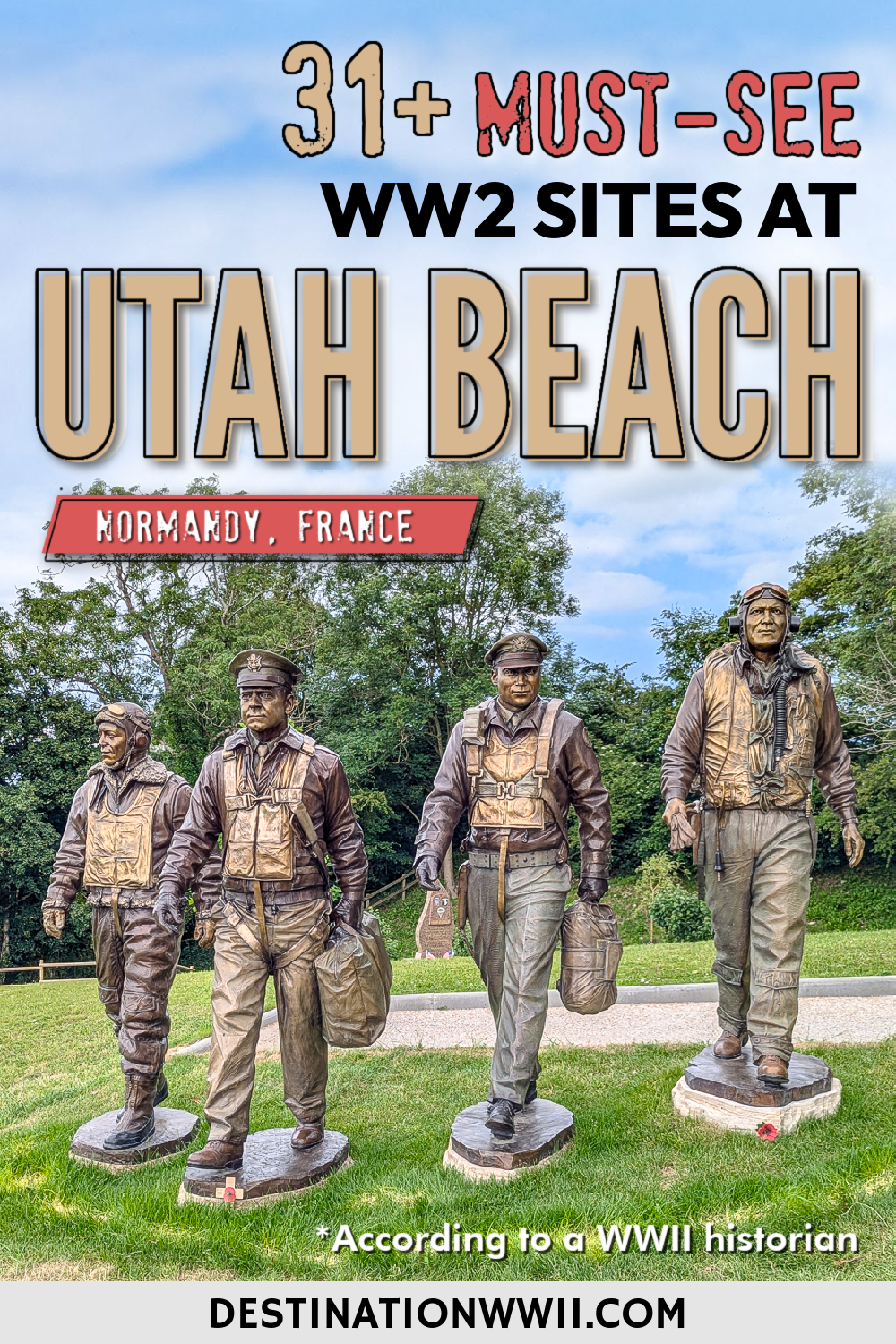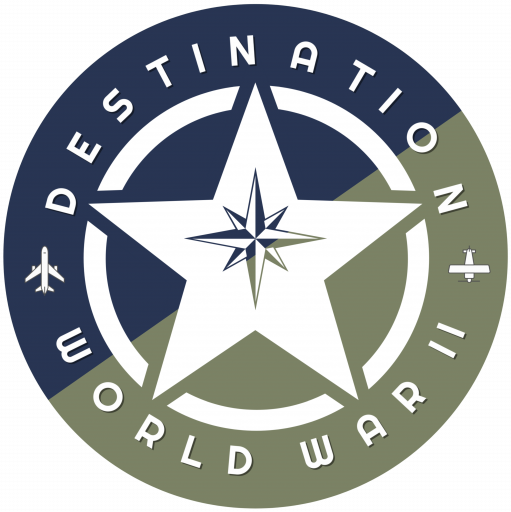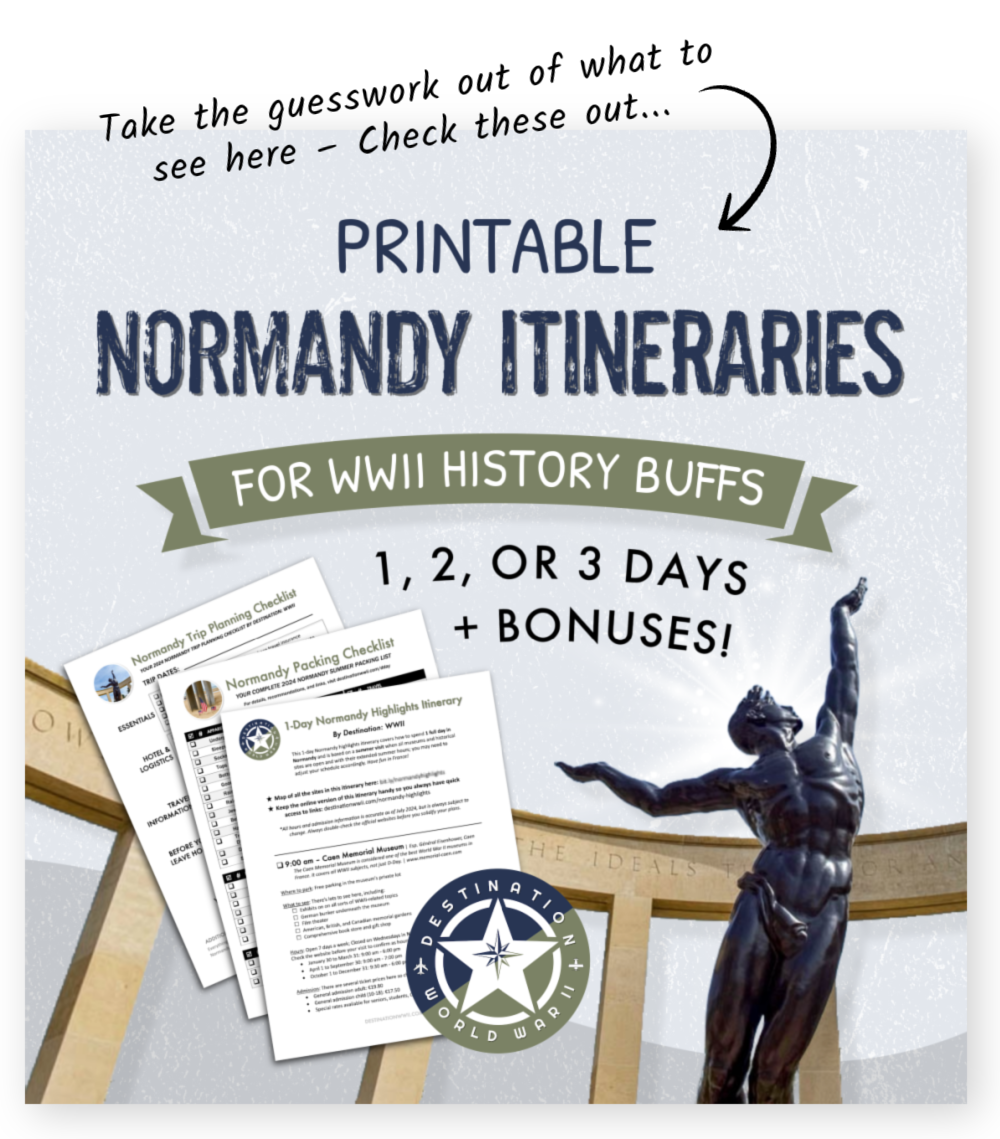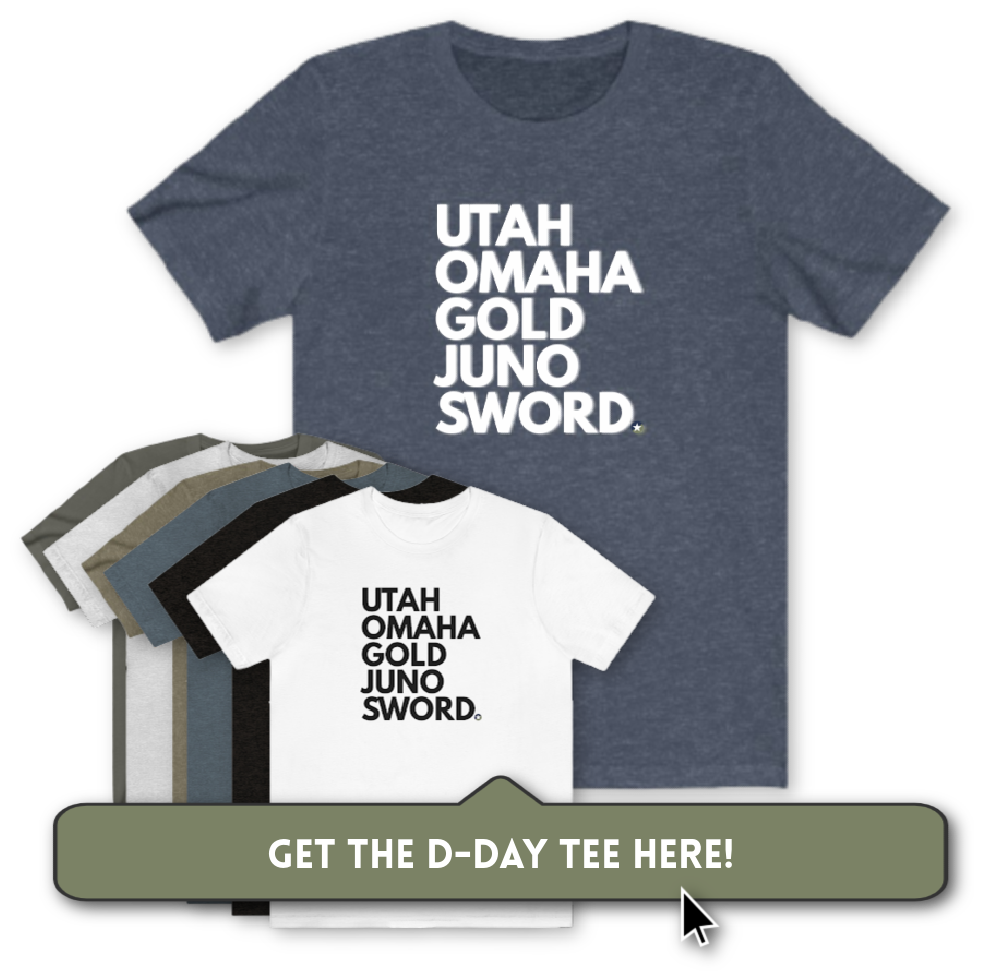When searching for what to see at Utah Beach in Normandy, you’ll quickly find that you’re very much in luck! There are so many things to see and places to visit here on Utah Beach (and the surrounding areas) for World War II enthusiasts. More than you’ll know what to do with, for real.
Utah Beach is the westernmost of the five Normandy beaches where troops landed on D-Day. (And it just so happens to be my personal favorite!) Along with neighboring Omaha Beach, Utah Beach was an American landing zone. Because of this, the majority of Utah Beach museums and monuments center around the heroism of the American troops.
Be sure to check out my posts on where to go at the other four D-Day landing beaches: Omaha Beach, Gold Beach, Juno Beach, and Sword Beach.
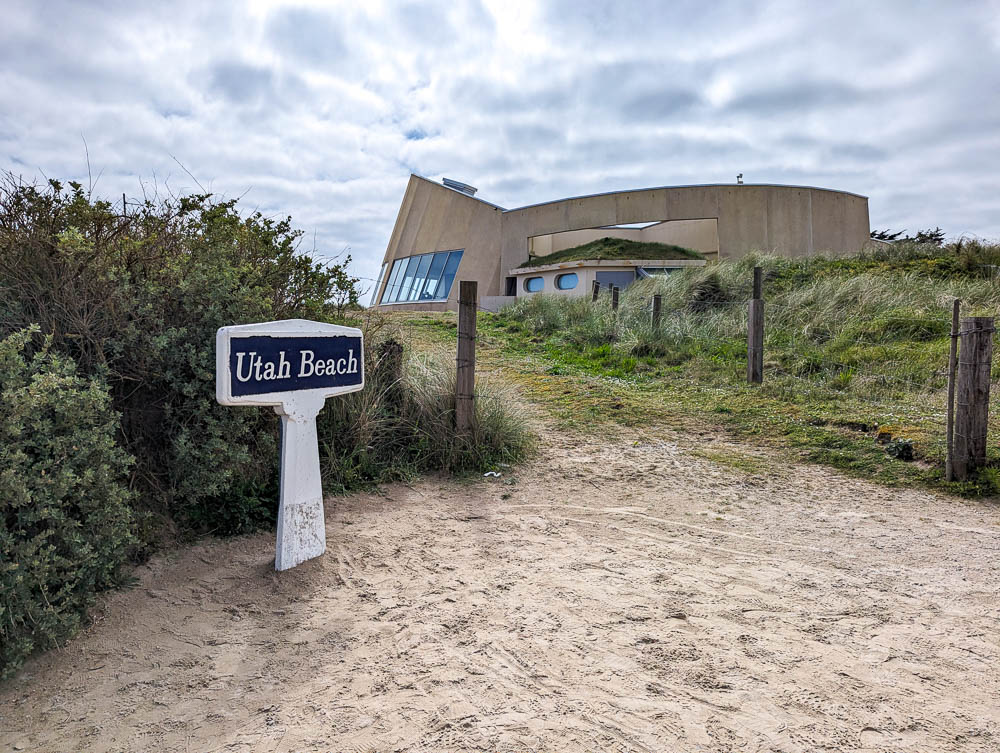
D-Day on Utah Beach: What happened?
The US actually added Utah Beach to the list of D-Day landing zones pretty close to the last minute, but it ended up playing a major role in the Allies’ success. Here’s a quick rundown of what happened after American troops invaded Utah Beach on June 6, 1944:
Utah Beach objective: Secure the Cotentin Peninsula and capture the port city of Cherbourg at the northern tip.
Utah Beach casualties: Of the 23,000 troops that landed on Utah Beach, casualties were relatively low at just 197 (including 60 missing).
Utah Beach units: Including air and amphibious landings, the units that landed on Utah Beach included:
- 82nd Airborne Division, commanded by Major General Matthew Ridgeway
- 101st Airborne Division, Major General Maxwell D. Taylor
- VII Corps, Major General J. Lawton Collins
- 4th Infantry Division, Major General Raymond O. Barton
- 90th Infantry Division, Brigadier General Jay W. MacKelvie
- 4th Cavalry Regiment, Colonel Joseph Tully
- 70th Tank Battalion, Lieutenant Colonel John Welbron
Utah Beach outcome: Success!
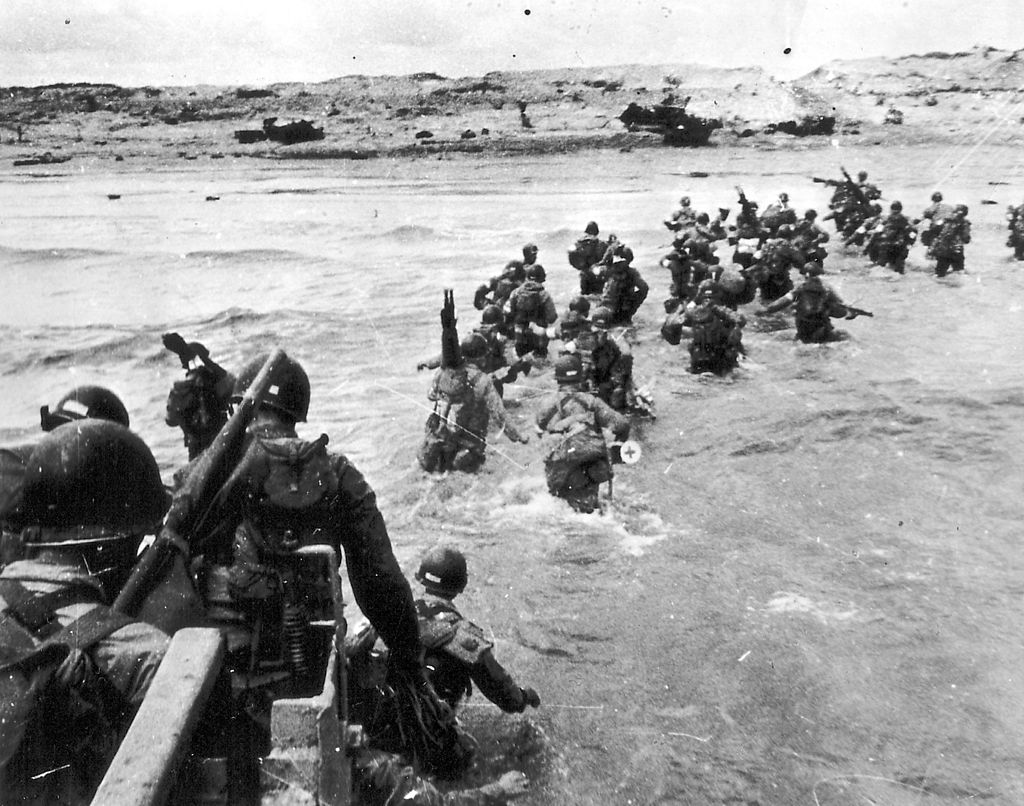
Also heading to Paris on your trip to France? Don’t miss all the WWII sites in Paris too and this post on the best Normandy day trips from Paris.
What to see at Utah Beach
You don’t really hear about what to see at Utah Beach all that much, but what I discovered is that there’s a lot more to see here than I ever expected. This list includes museums, memorials, monuments, and a few more categories of miscellaneous historical sites and other cool spots to add to your Normandy itinerary.
This list includes not just what to see at Utah Beach itself, but also the sites scattered throughout the entire Utah Beach landing sector. Every stop on this list is still within a 20-minute drive from the beach.
Also check out: What you need to know about driving in Normandy + helpful tips
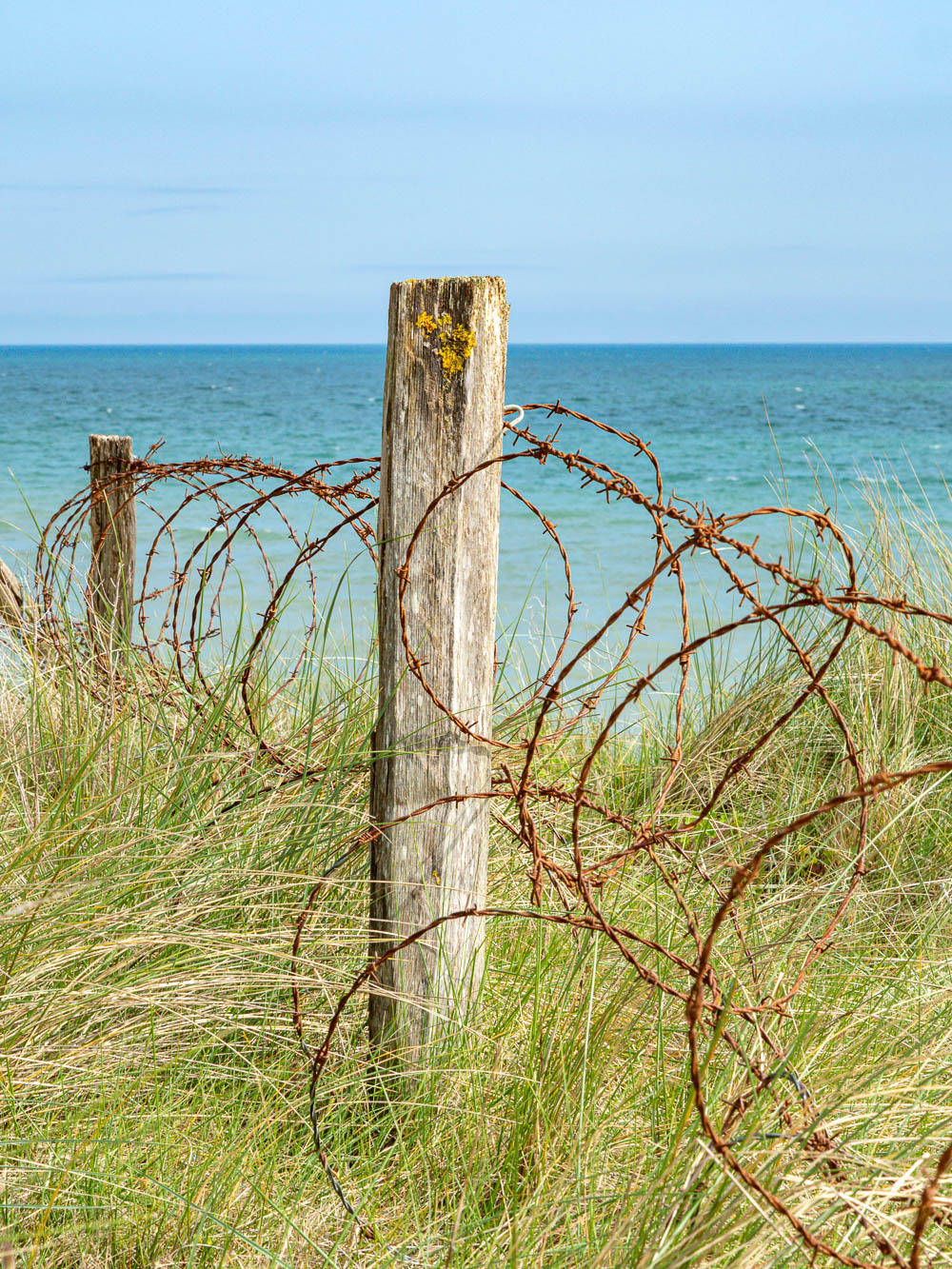
Map of Utah Beach sites
This map contains all the Utah Beach sites I talk about in this post. To save this map: Click on the star ⭑ next to the map’s title to save in your Google Maps. To use this map: When you get to Normandy, open Google Maps on your phone, click “Saved” at the bottom, then click “Maps.”
1. Utah Beach itself
While there’s a lot to see in and around Normandy’s Utah Beach, don’t forget about the actual beach itself. Normandy’s D-Day landing beaches are blissfully undeveloped and you can roam around as you please. These beaches are wide and empty and make it easy to image the events of 1944.
Spend some time strolling the beach thinking about the events of June 6th, of the lives and families forever changed as a result of what took place here. The struggles and fear and loss. Utah Beach may have been the one with the fewest casualties, but its success did not come without sacrifice. Take off your shoes and feel the sand beneath your feet.
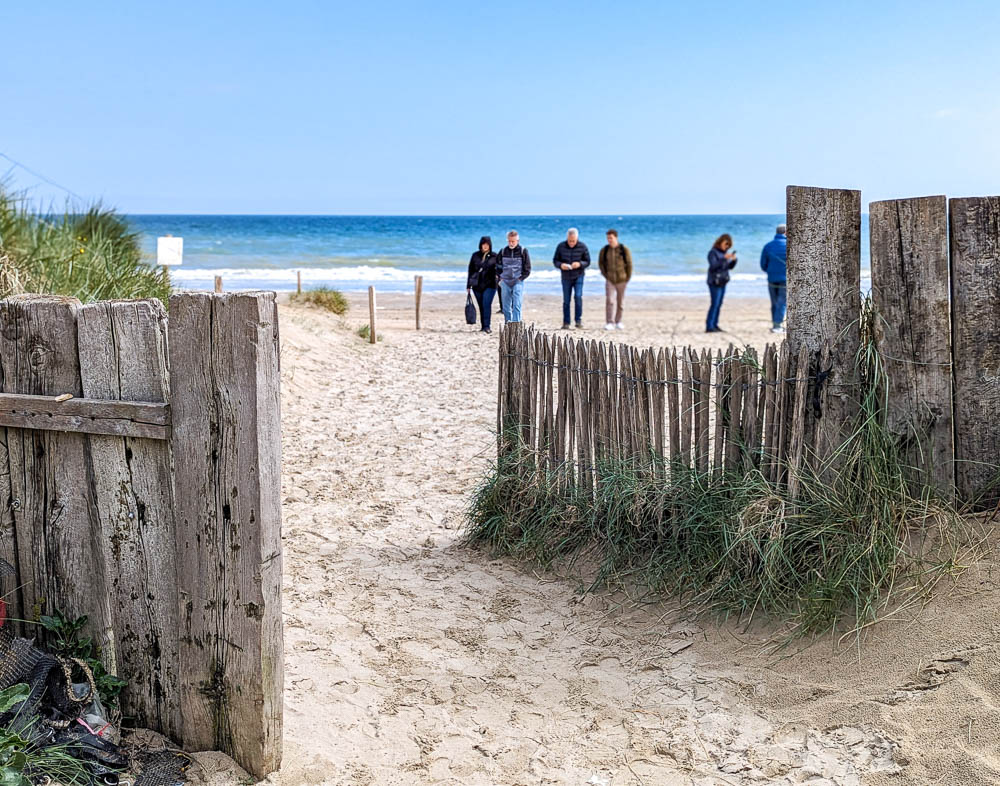
Parking at the beach is both plentiful and free. Put the Utah Beach Landing Museum into your GPS and park wherever you can find space—in the grass along the fence line, in one of the small parking areas, etc.
Also read: 10 Things You Need to Know Before Visiting Normandy’s D-Day Sites

2. Utah Beach Landing Museum
Built atop a former German bunker is the Utah Beach Landing Museum. At this museum you can learn all about D-Day—from the initial preparations through the final outcome—but also about the Utah Beach landings specifically.
This museum can feel a bit unorganized or, at least, scattered at times, but it does have an incredible collection of artifacts on display. Forget trying to follow a discernible flow and just examine the exhibits as you come to them. One of the most popular pieces here is an original B-26 bomber—one of only six left in existence.
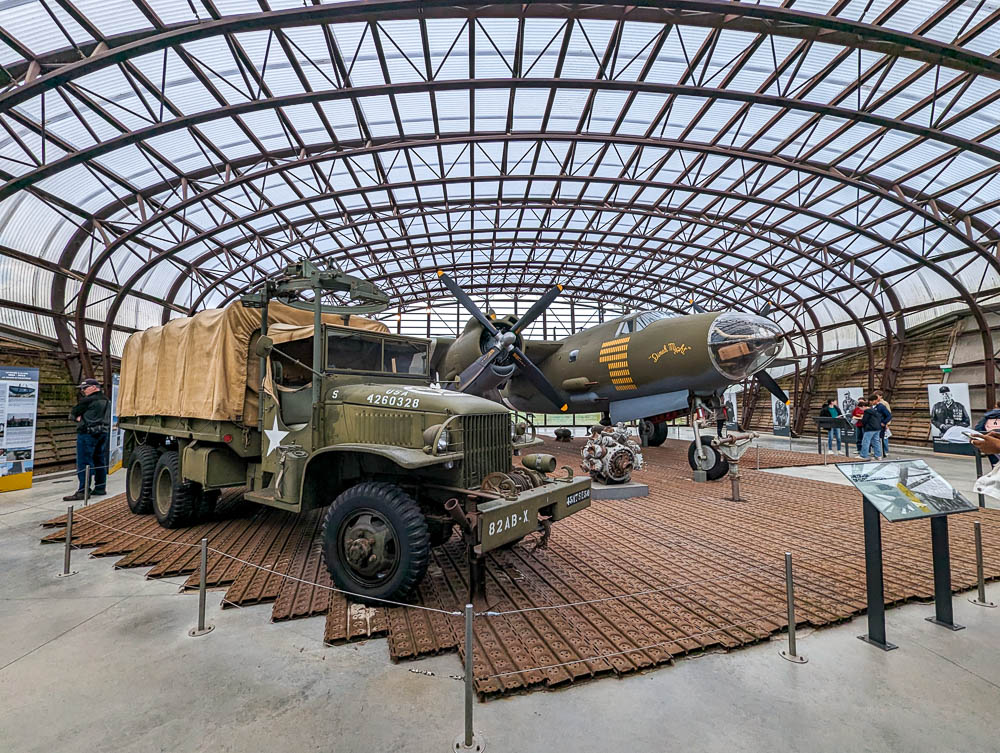
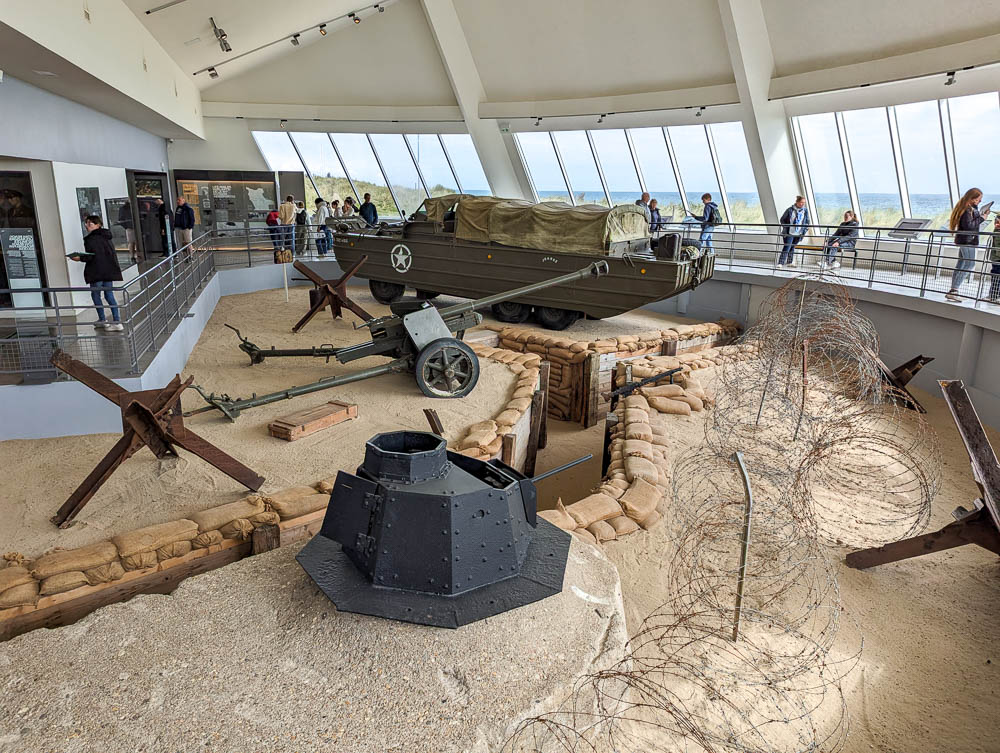
Also check out: 14 awesome WWII museums in Normandy you should consider visiting while you’re here. You can find out more about the Utah Beach Landing Museum in that post as well.
3. Utah Beach Monuments & Memorials
In the same general area as the Utah Beach Landing Museum you’ll find a collection of monuments and memorials honoring various army divisions and more. Here are some (but certainly not all) of the Utah Beach monuments to look out for:
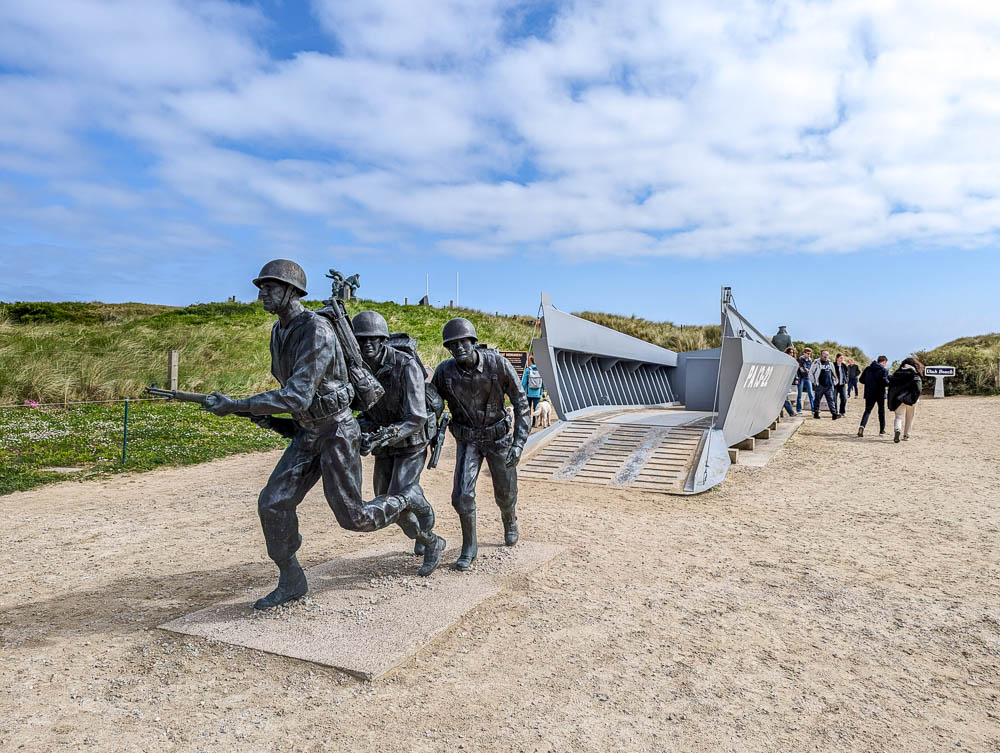
4. Higgins Boat Monument
On D-Day, Americans came ashore onto the beaches of Normandy in amphibious crafts known as Higgins boats. (So named for their inventor—Andrew Jackson Higgins of New Orleans.) At this point in the war, the US military had used Higgins boats in all its amphibious landings: North Africa, Italy, southern France, and the Pacific.
These water crafts were operated by a 4-man crew, could carry 36 troops, and could be fitted with two Browning M1919 machine guns. On D-Day, 1,089 Higgins boats were utilized in the Normandy landings. You may also hear them referred to as LCVPs which stands for Landing Craft, Vehicle, Personnel.
The Higgins Boat Monument at Utah Beach is a replica LCVP commemorating the roles these boats and the men who rode them ashore played in the Allied victory. It was donated by the citizens of Columbus, Nebraska—Andrew Higgins’ birthplace. Next to it you’ll find a sculpture of Higgins himself.
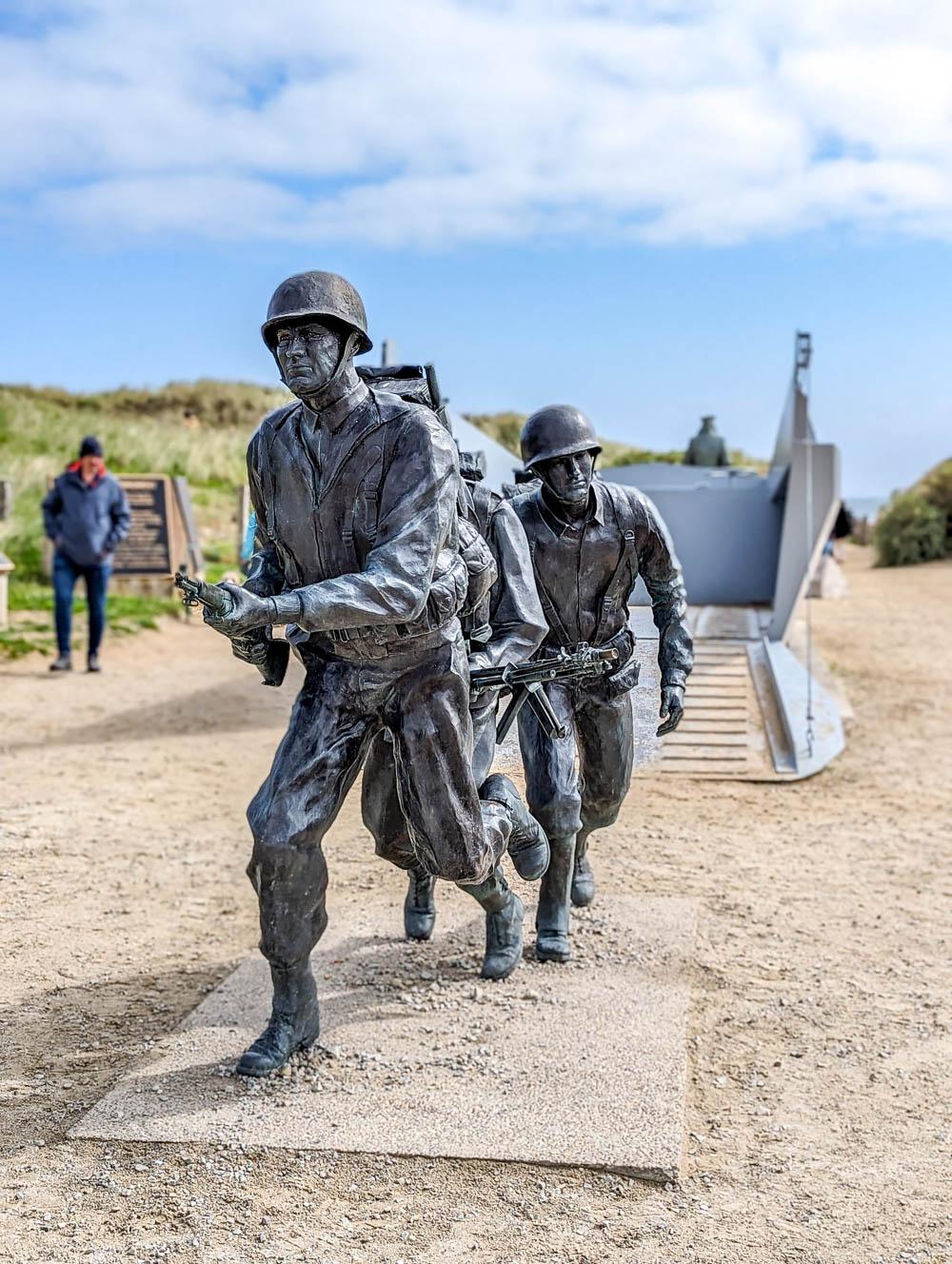
5. US Navy Monument
The US Navy Monument at Utah Beach consists of three figures circling each other which are meant to represent leadership, sailors, and combat units. Inscribed on the sculpture’s base are the names of the American ships that participated in Operation Overlord (i.e., the Battle of Normandy). Until 2022, this was the only monument to the United States Navy that existed outside of the US.

6. Lone Sailor / Frogmen Monument
Now, just behind the Higgins monument stands the Lone Sailor Monument dedicated to the “frogmen” of the US Navy (the forerunners of today’s SEALS). As the monument states:
During the first hours of D-Day, 175 Naval Combat Demolition Unit “Frogmen” landed on Utah and Omaha beaches to clear obstacles in advance of the amphibious landing. Of the 175 Sailors, 91 were killed or wounded, a casualty rate of 52%, one of the highest endured by any unit of the US Armed Forced during D-Day.
You can find other Lone Sailor statues in 18 locations around the world, including at the Pearl Harbor Visitor Center in Oahu and on Navy Memorial Plaza in Washington, D.C. You can find all the locations here: navymemorial.org

7. 90th Infantry Division Monument
Utah Beach’s 90th Infantry Division Monument features the division’s sleeve insignia carved in stone and honors “the memory of the heroic dead of the 90th Infantry Division, U.S. Army, 6 June 1944 – 9 May 1945.”
After landing on Utah Beach, the 90th continued inland through northern France, then onto Bastogne, Belgium and the Ardennes for the Battle of the Bulge. It eventually moved into Germany where it helped liberate the Nazi concentration camp at Flossenbürg. This monument was constructed from granite taken from the quarry at Flossenbürg where the camp’s prisoners were forced to work.
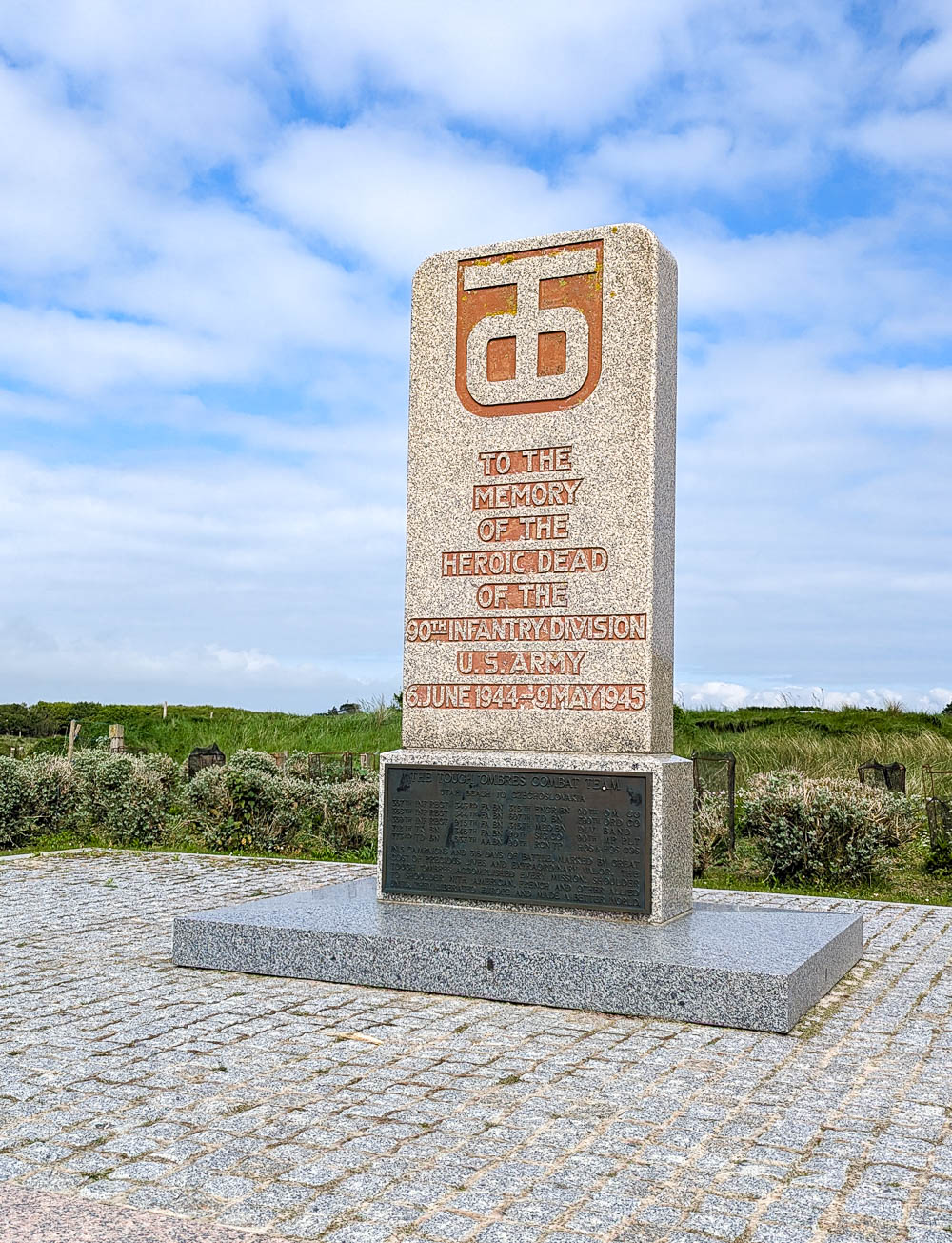
8. 1st Engineer Special Brigade Memorial & Bunker
To the north of the Utah Beach Landing Museum on an elevated platform you’ll find the memorial to the 1st Engineer Special Brigade. Climb up the stairs to check out the memorial or head under the stairs to check out the former German bunker.
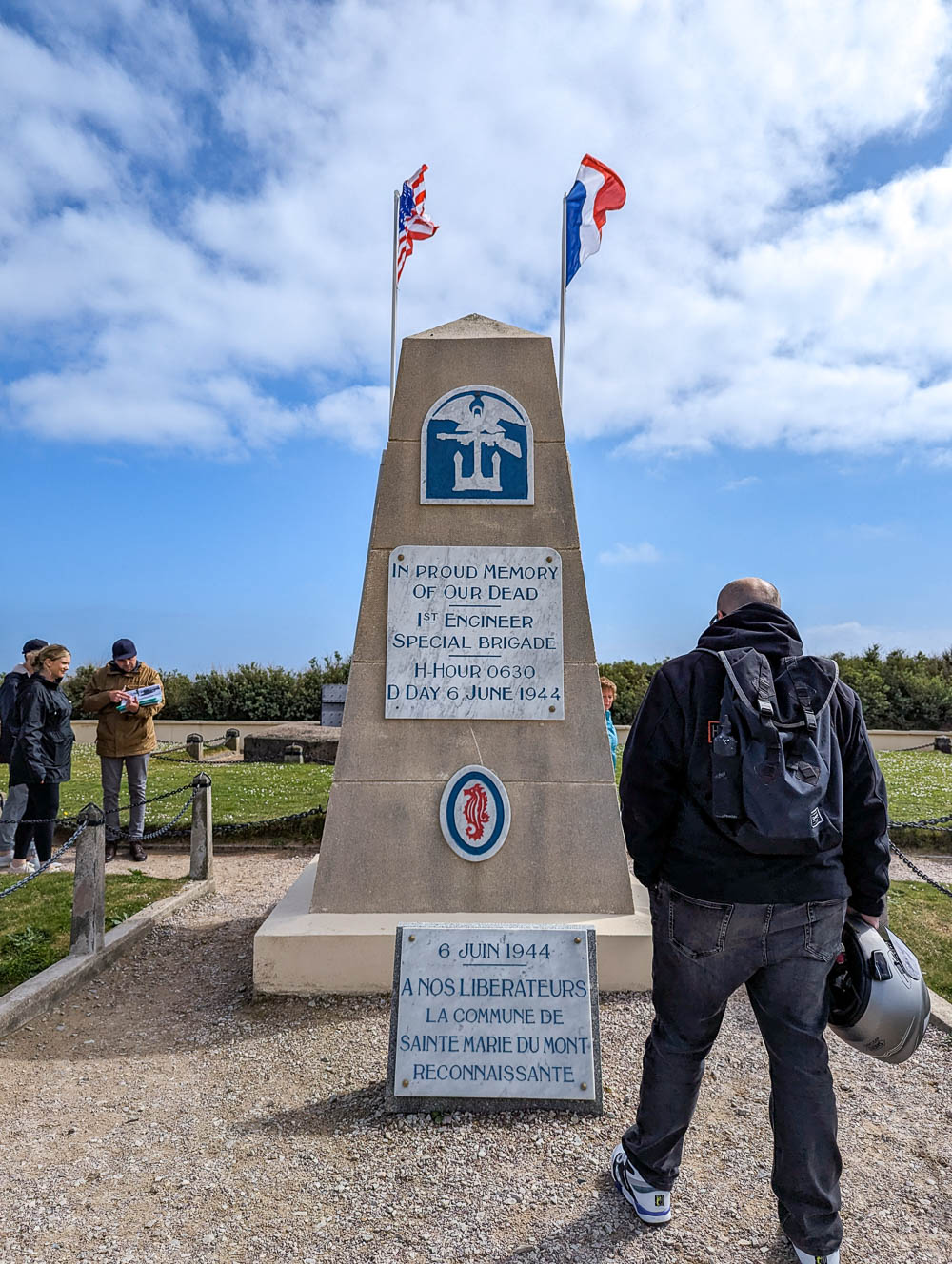
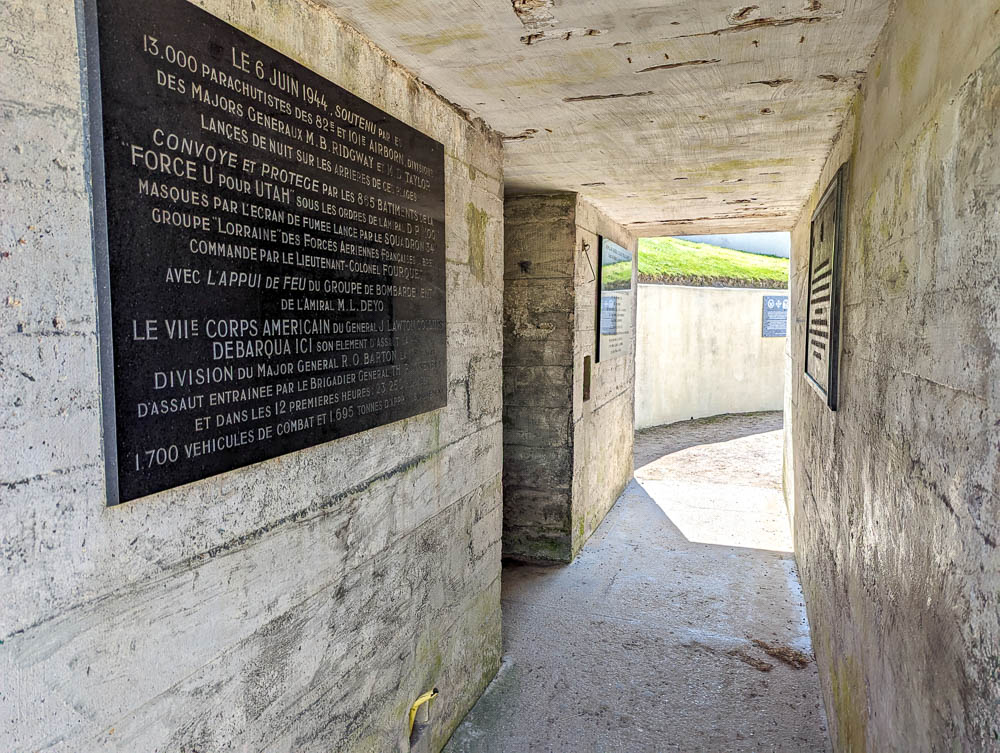
9. Utah Beach D-Day Landing Memorial Plaza
Further up the beach (about a 7-minute drive north) you’ll find the Utah Beach D-Day Landing Memorial plaza which contains a handful of monuments of its own, like:
- The Monument to the Landing of the French 2nd Armored Division
- The U.S. 8th Infantry Division Memorial
- Some information panels on the French 2nd Armored
- A couple of tanks + more
Parking here is also free but spots are relatively limited. When I visited in May 2024 there was also a food truck here serving lunch which I think is a regular occurrence. At low tide, take a walk out onto the beach directly behind here and you can see some of the remains of the artificial harbors up close.
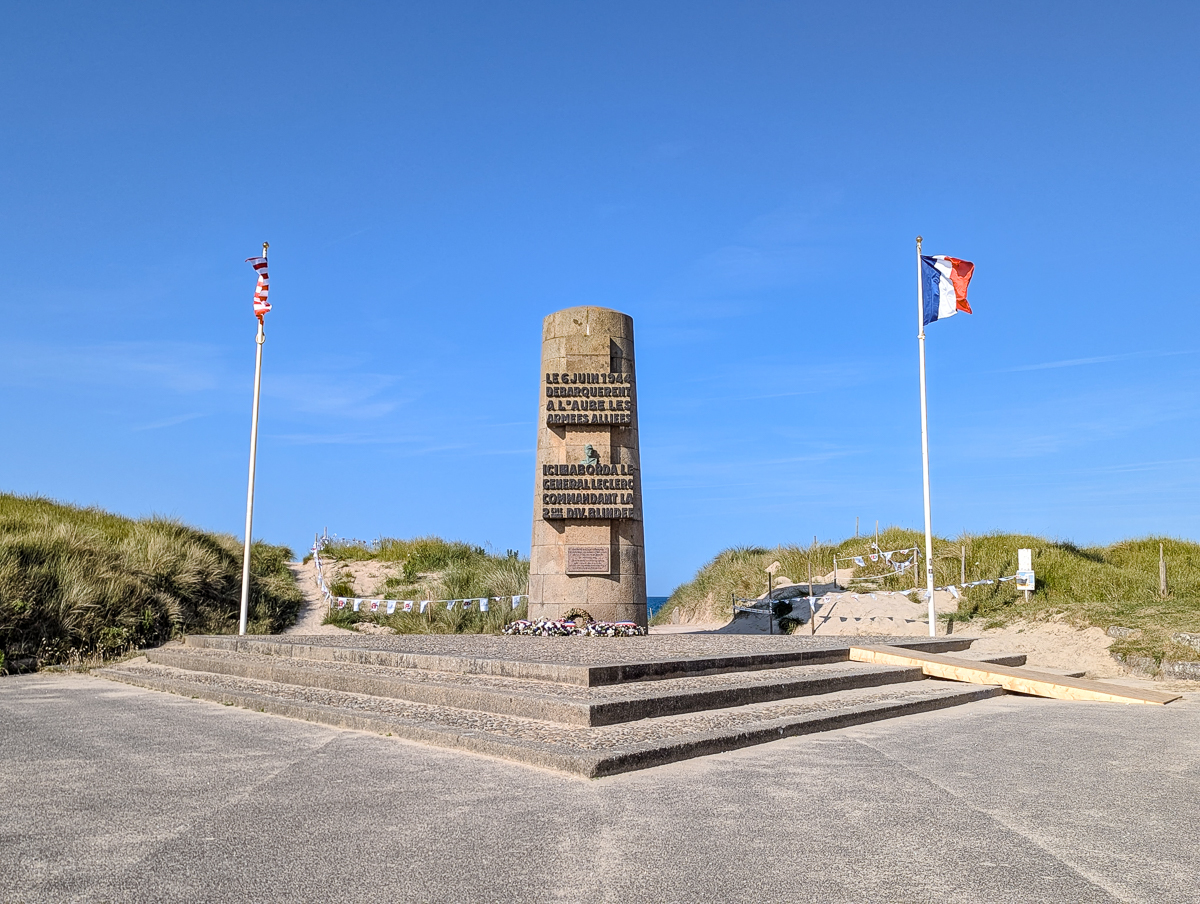
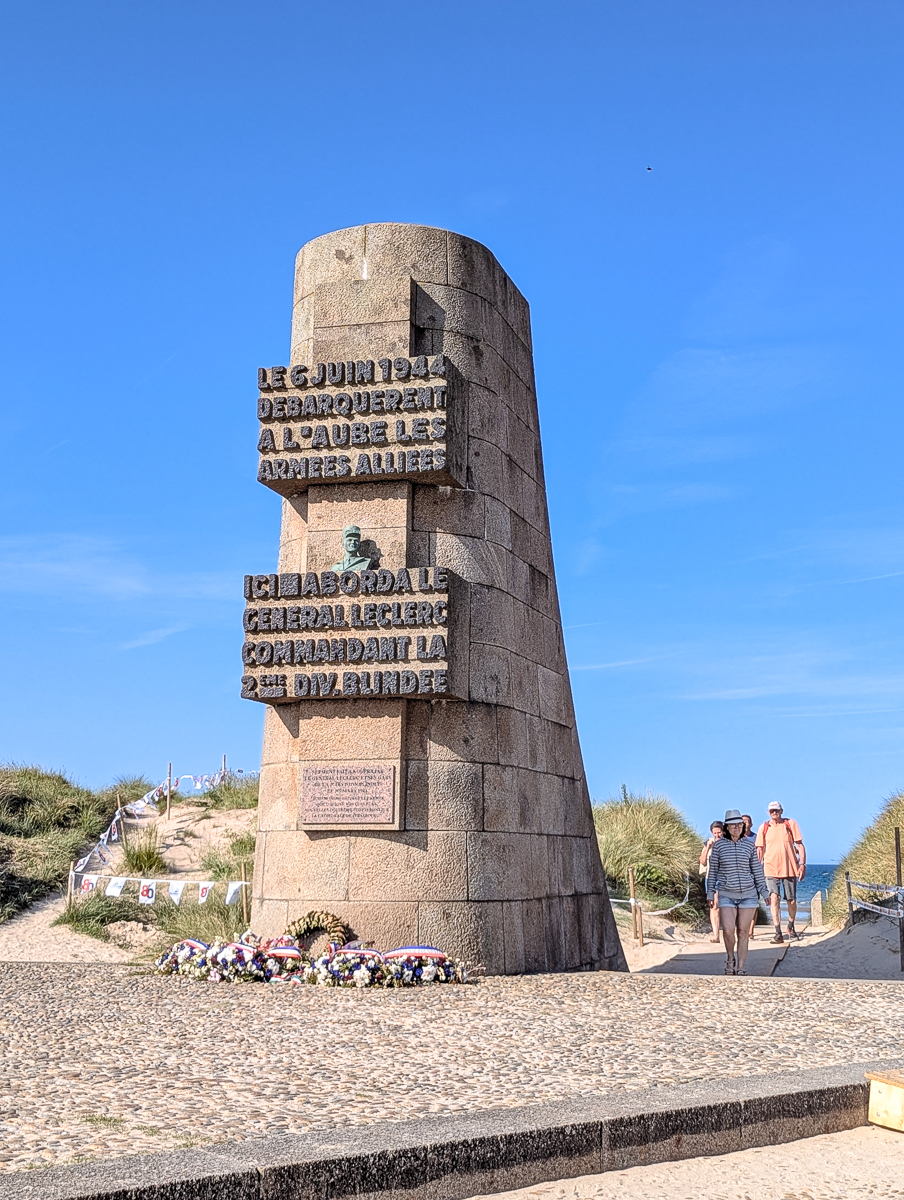
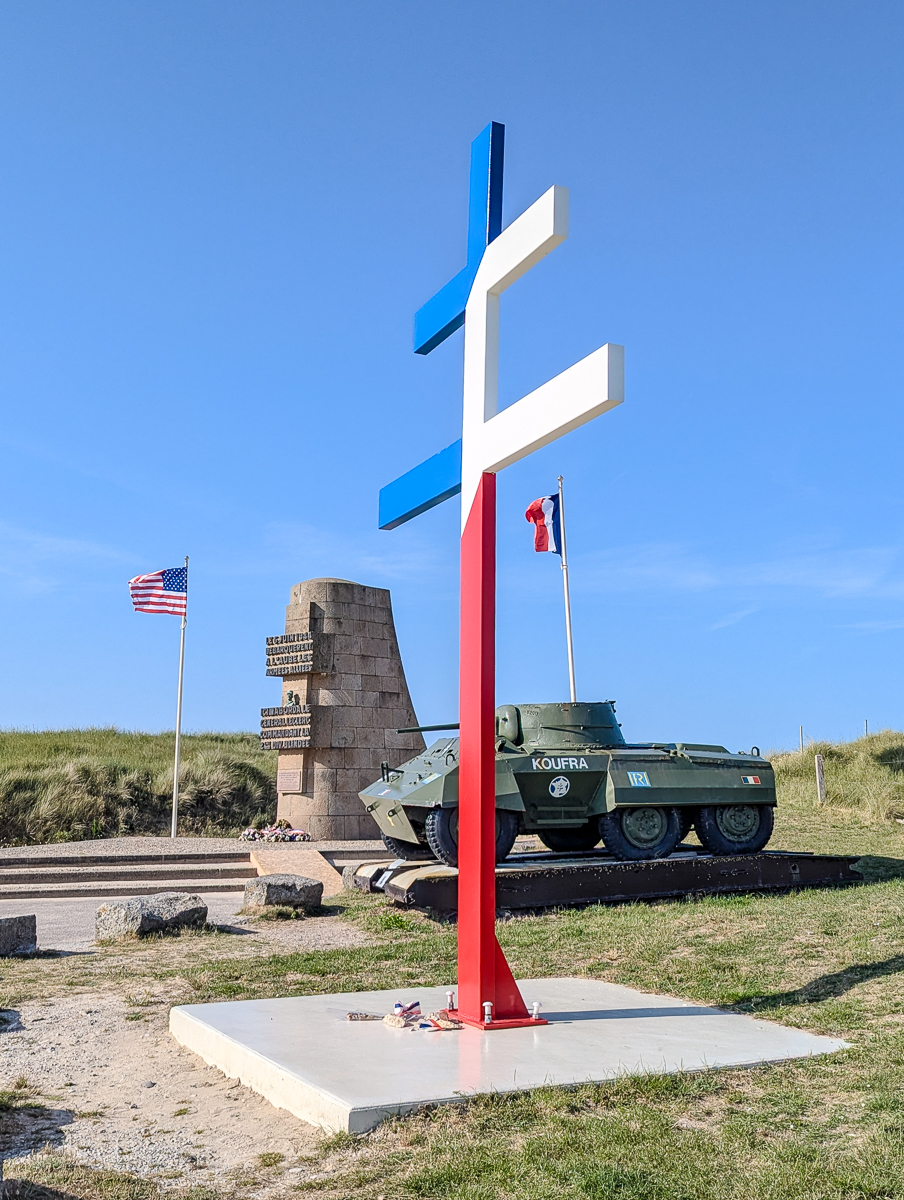
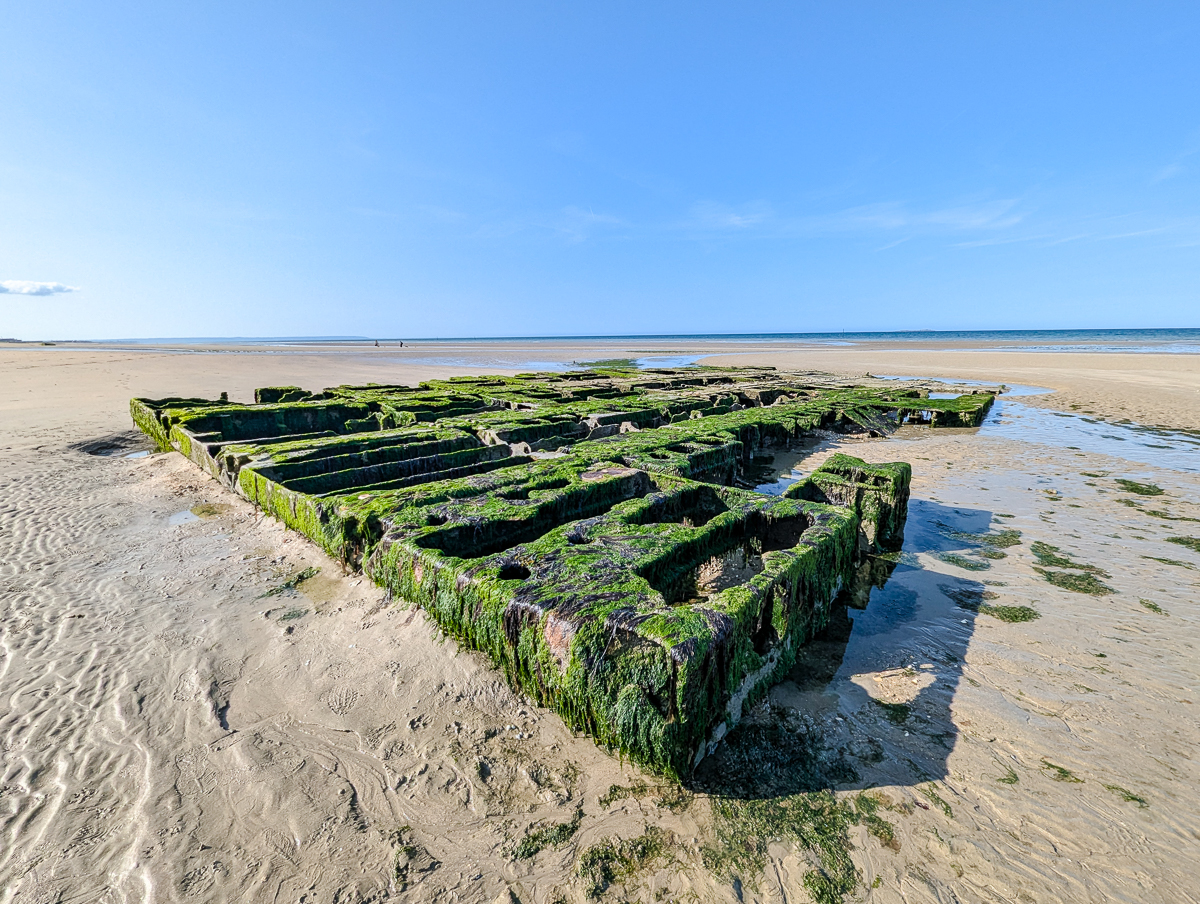
10. Le Roosevelt
Because in this case, what to see at Utah Beach also means where to eat. Directly across the path from the Higgins Monument is Le Roosevelt—a small café, restaurant, and gift shop.
Le Roosevelt is named after American General Theodore Roosevelt, Jr.—eldest son of former president Teddy Roosevelt and cousin to the current president (at the time), FDR. Roosevelt Jr. landed at Utah Beach with the 4th US Army Infantry Division and received the Medal of Honor for his role in the Normandy beach landings. (He’s pretty legendary around here.)
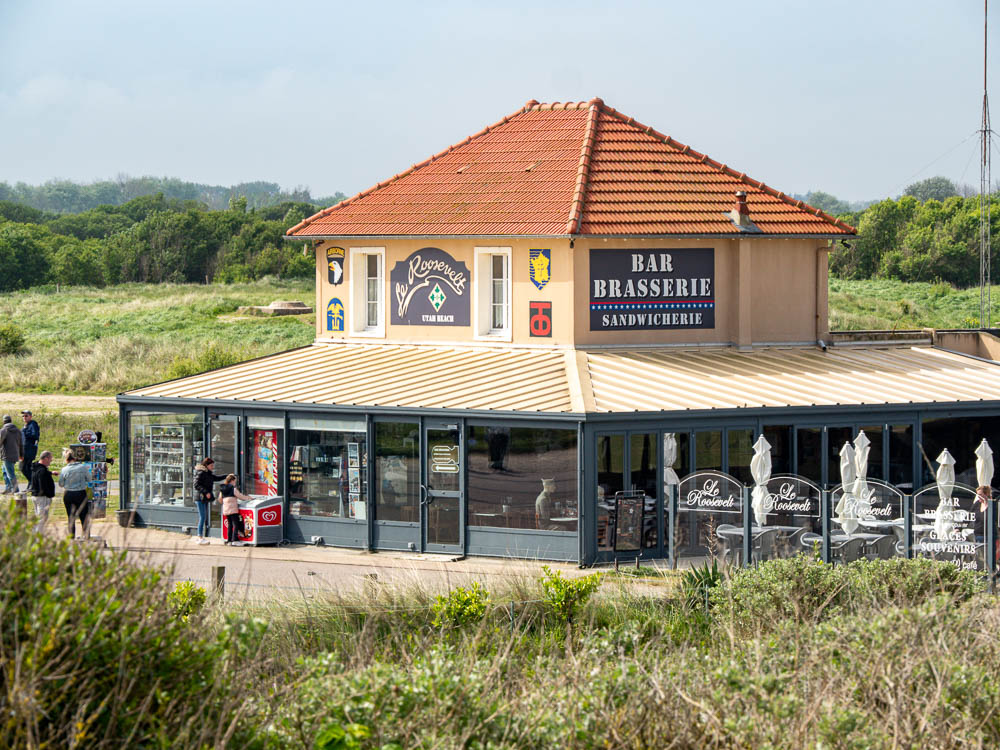
During the war, this building was a simple fisherman’s house that had been taken over by German forces… that was then taken over by US troops on D-Day.
Today, Le Roosevelt is an interesting spot to grab a drink or a meal in a truly historic building. (I had the “French hot dog” for what it’s worth.) This place is full of WWII memorabilia, historical artifacts, and thousands of signatures and photos from veterans. Check out the video on their website for a cool look inside: leroosevelt.fr.
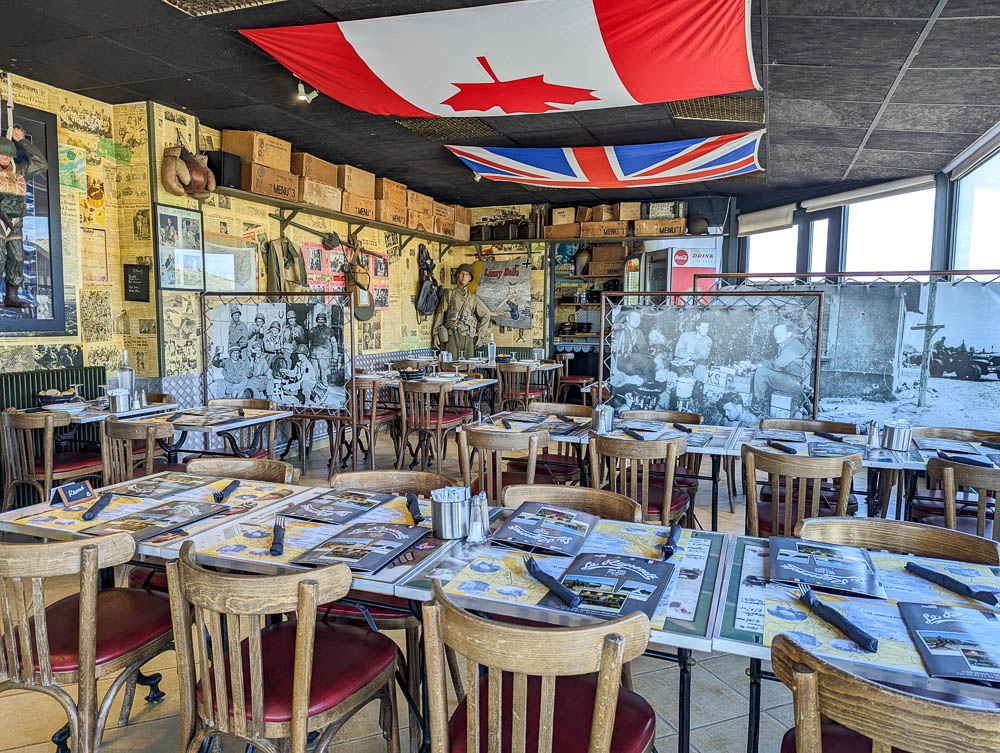
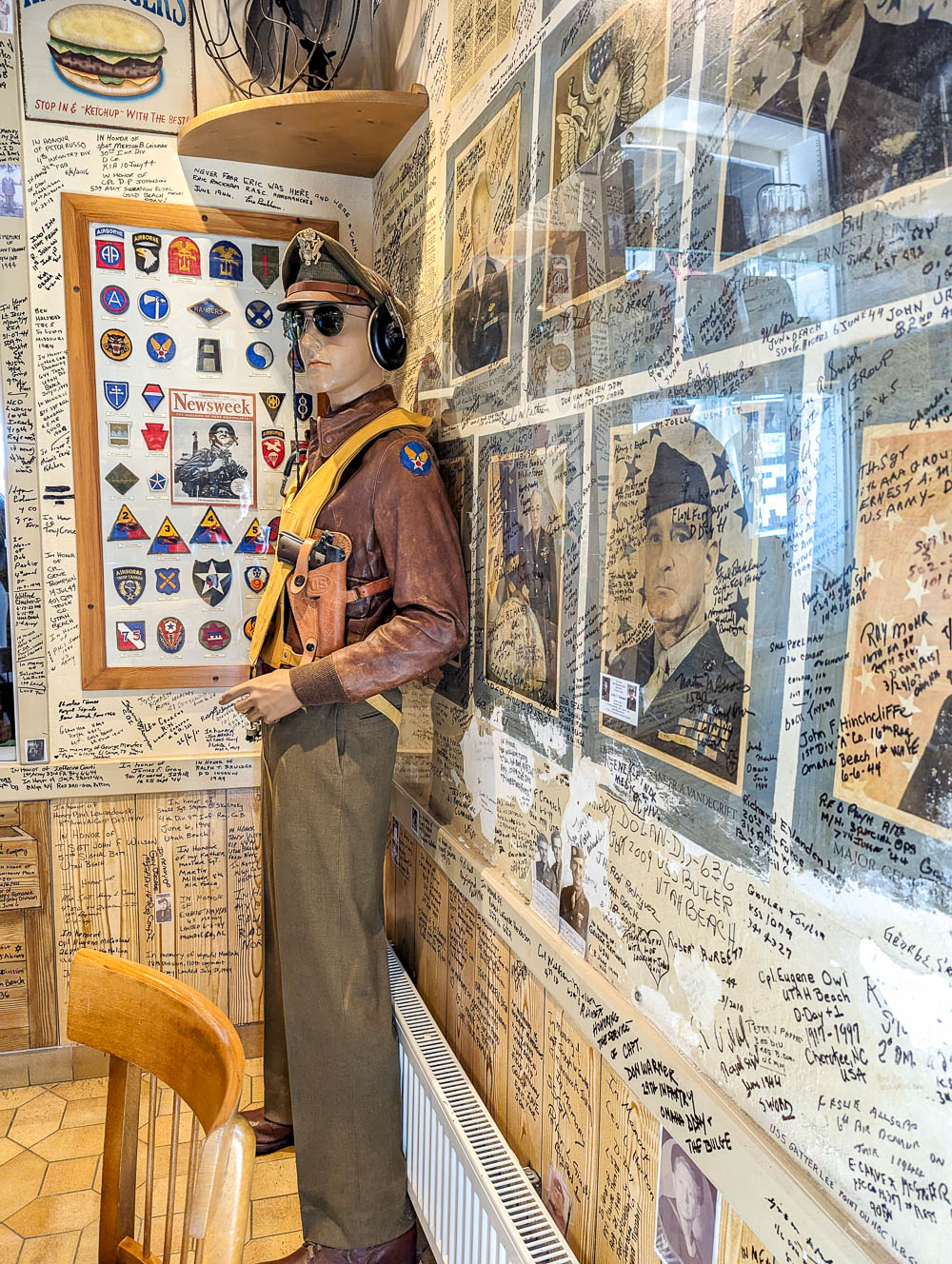
11. The many countryside memorials
Leaving the beach and heading back into the countryside you’ll find several more monuments and memorials. Many of them line the local roads and have small areas for pulling off to view them, like:
Monument to the French Resistance
This monument features three characters–a boy with a bike, a woman sitting at a table, and another man with a gun. These symbolize some of the foundations of the French Resistance movement: the Underground, the Auxiliary, and the Guerrilla fighter. Two plaques commemorate the critical role the French Resistance played in Operation Overlord’s success.
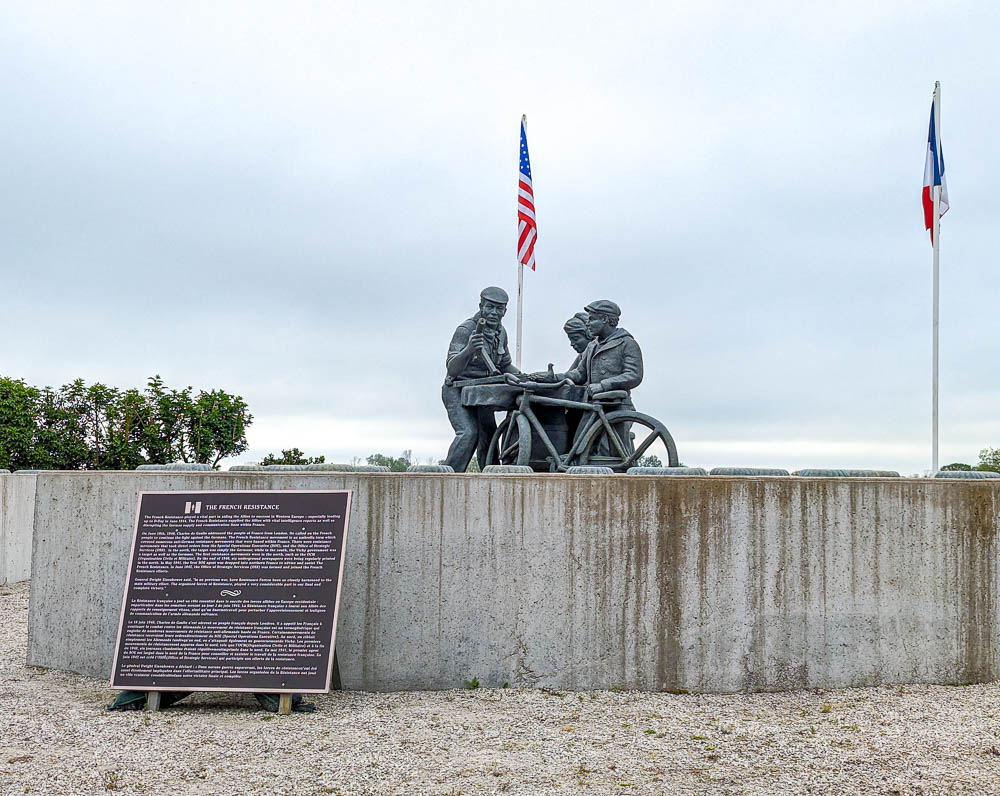
12. Iron Mike Memorial (Mémorial de la Fière)
This dedicated memorial area contains a few moving tributes. First, the Iron Mike Memorial–a statue of a paratrooper, named after the patron saint of the Airborne, St. Michael. The base of the statue includes a brief summary of the battle that took place here as well as a dedication to General James M. Gavin.
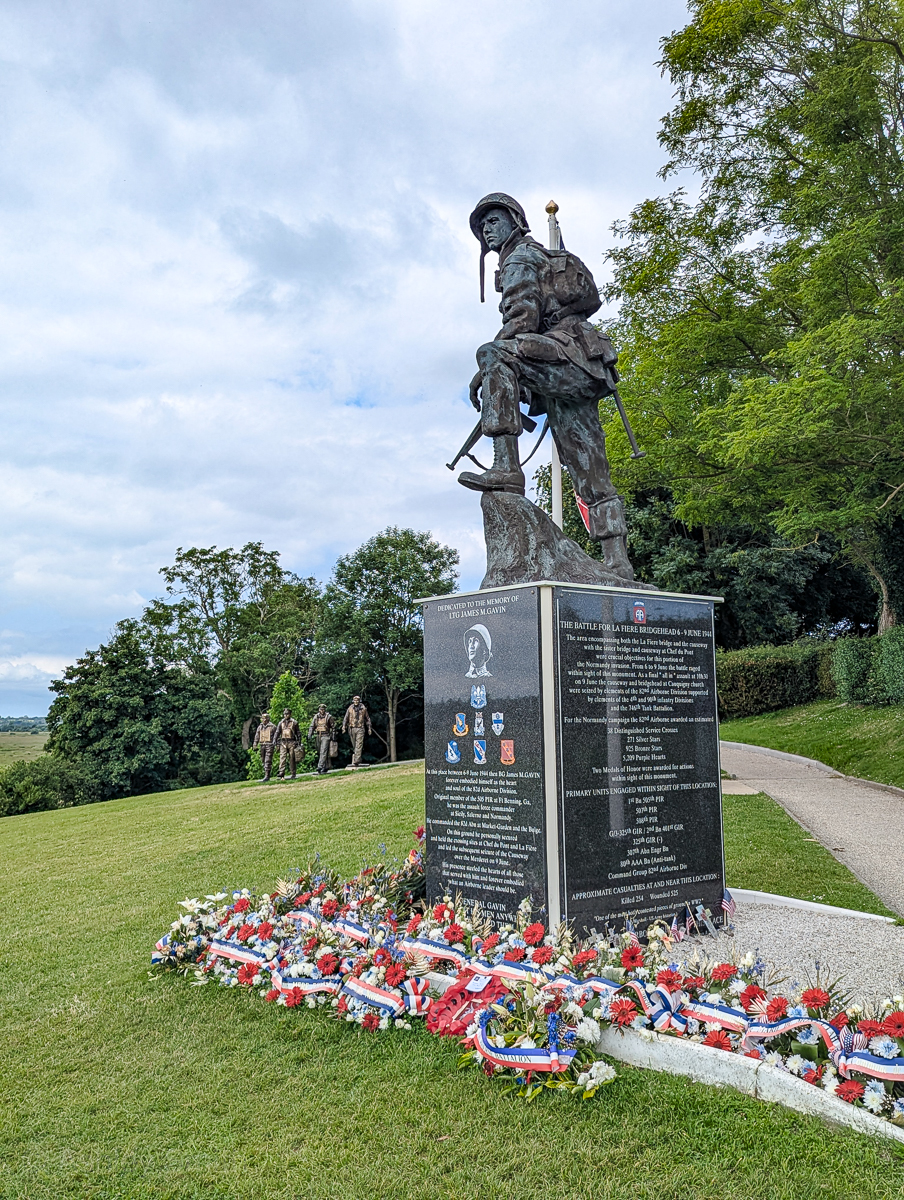
13. The Mighty Eighth Air Force Monument
Directly next to Iron Mike is this brand-new monument (dedicated June 5, 2025). It features four life-sized (and lifelike) bronze statues of distinguished airmen. These include:
- SSGT. Maynard “Snuffy” Smith – Gunner
- Lt. Col. Robert “Rosie” Rosenthal – Pilot
- Gen. James “Jimmy” Doolittle – Commander
- Col. Donald “Don” Blakeslee – Commander
The men of the Eighth Army Air Force (the “Mighty Eighth”) flew more than 2,300 sorties on D-Day alone and suffered more than 26,000 fatalities during World War II.
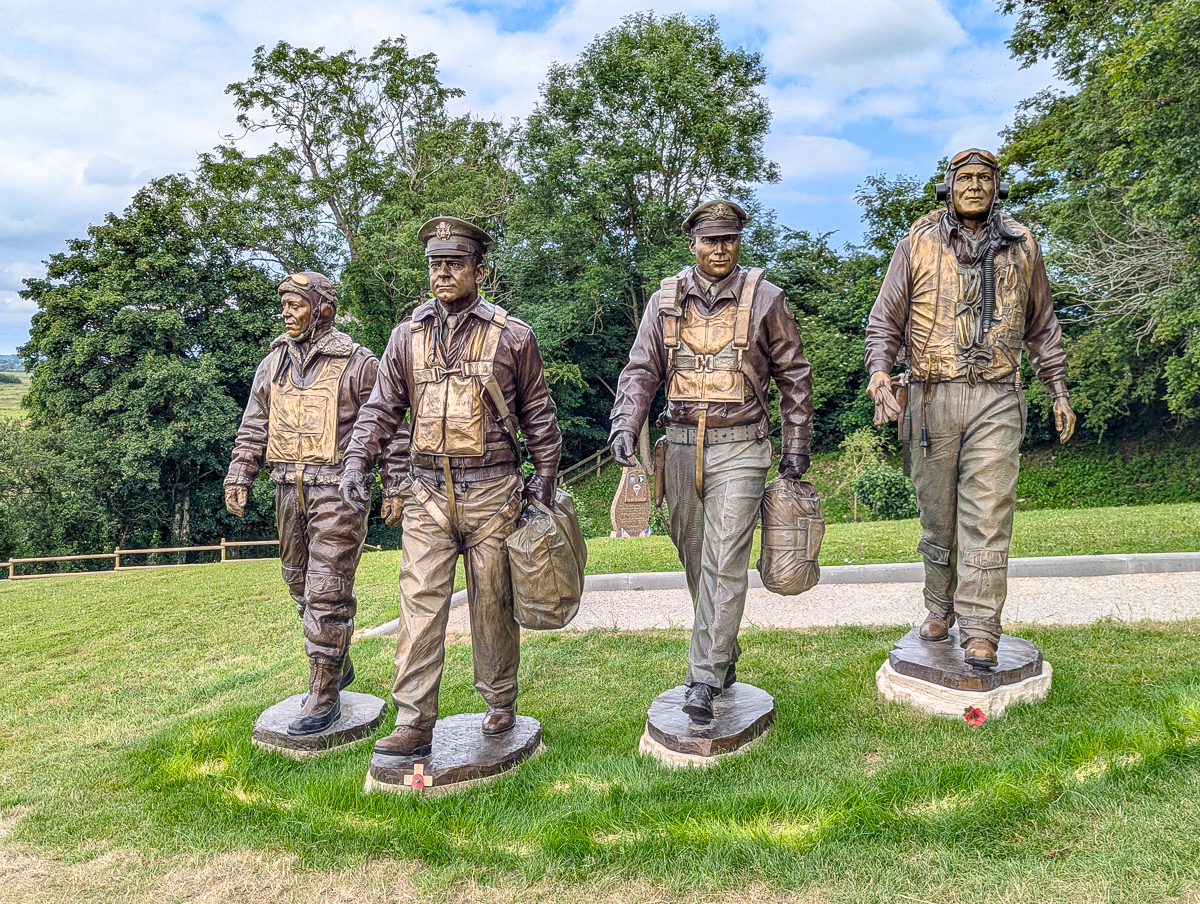
14. Memorial to Danish Seamen
This monument honors the 800 Danish sailors who contributed to D-Day’s success. Though Denmark wasn’t entirely an Allied nation—they were initially neutral, then began to cooperate with Germany after being occupied by them—it did have a large resistance network.
Proving that not all of Denmark held allegiance to the Nazis, these 800 men fought alongside the Allies, storming the beaches of Normandy and beyond. This is the only monument in France honoring Danish contributions to Europe’s liberation.
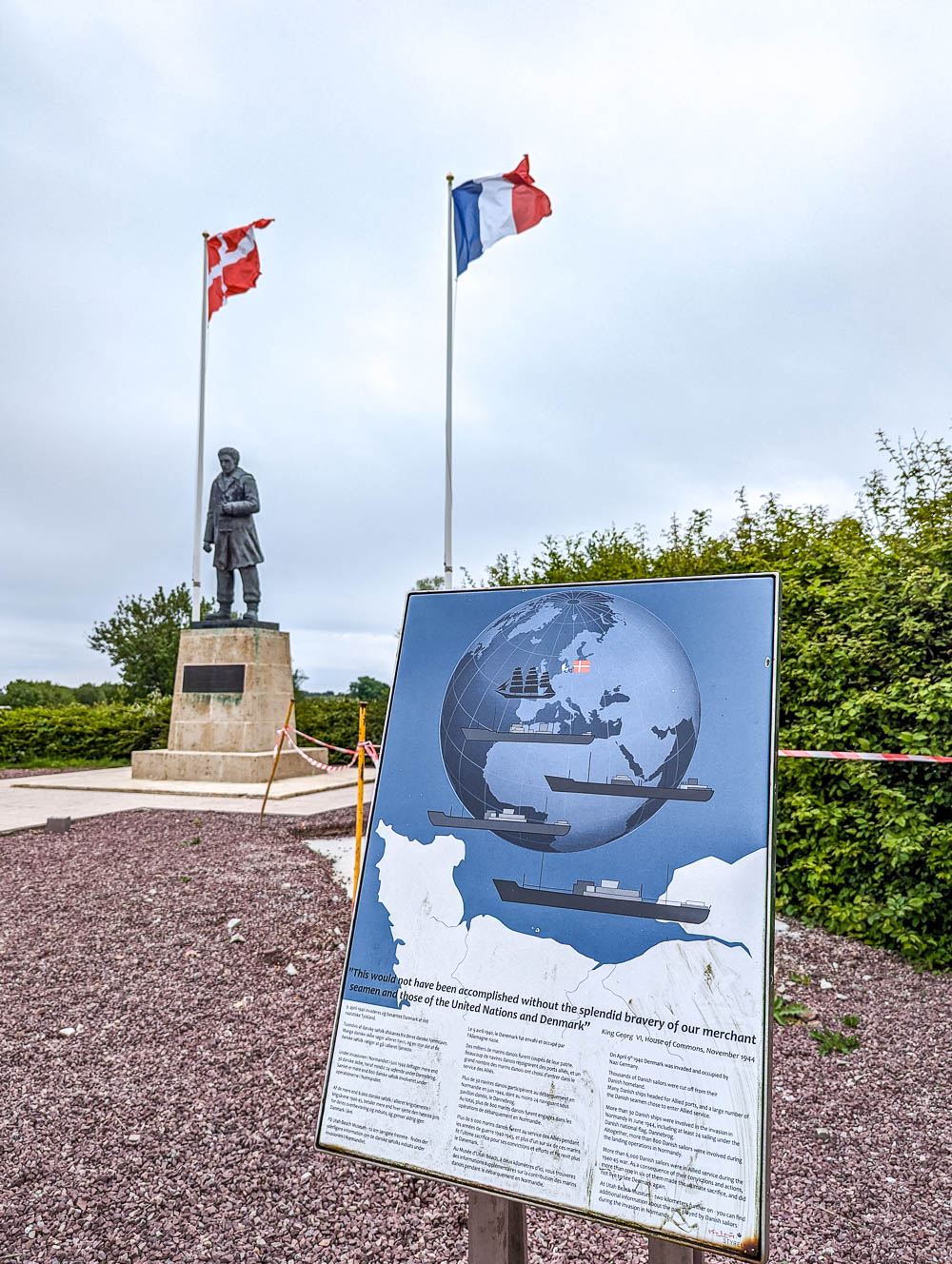
15. Richard D. Winters Leadership Monument
This monument ultimately honors the leadership of American troops during Operation Overlord, but it uses Major Richard “Dick” Winters as its symbol.
Major Dick Winters was a US Army officer who commanded the 101st Airborne Division’s Easy Company. He was made a household name (at least, in WWII-fanatic houses like mine) thanks to the HBO miniseries Band of Brothers. He was portrayed by actor Damian Lewis.
Winters parachuted into Normandy on D-Day alongside his men and fought through France, the Netherlands, Belgium, and Germany.
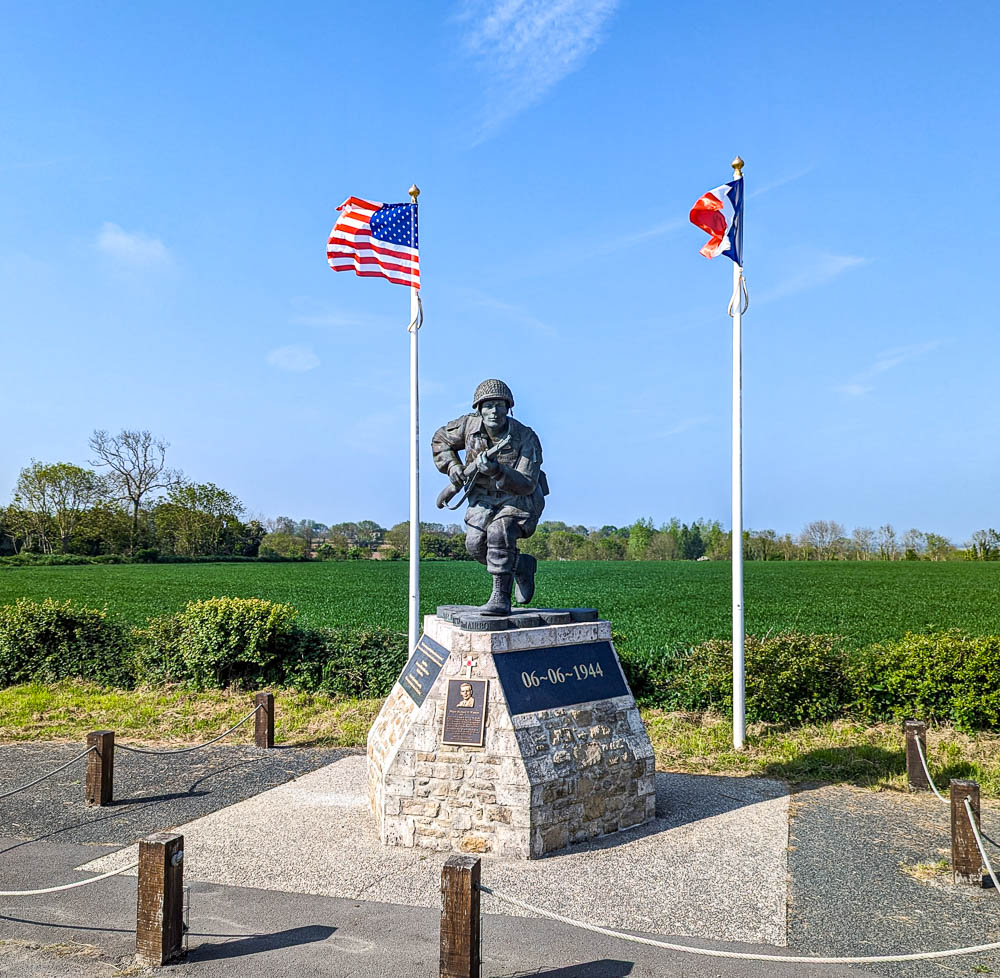
You can currently stream Band of Brothers on Amazon, Netflix, and Hulu. Or pick up the original Band of Brothers book here.
16. Easy Company Memorial
Just around the corner from the Dick Winters memorial is the Easy Company memorial. This monument is located near Brécourt Manor where Major Winters and his team destroyed a German artillery battery. In doing so they found a map showing all German artillery and machine gun positions on the Contentin Peninsula. (Band of Brothers features the Battle of Brécourt Manor in episode 2.)
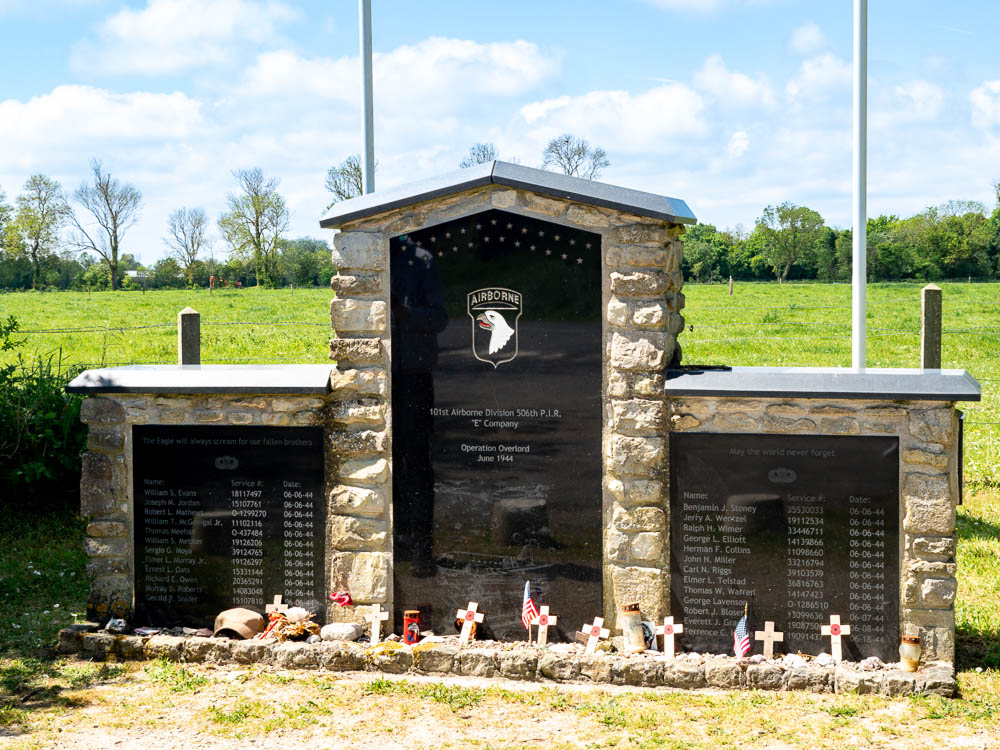
If you have limited time in the Normandy area, you can still see many of the best places to visit here. Check out my post on the 7 best D-Day sites to visit in Normandy if you only have one day.
17. D-Day Experience Museum
The D-Day Experience Museum is well-known for its C-47 flight simulator, but this museum is so much more than that! While a ride on the simulator is something you can do here, I actually found the rest of this museum to be one of the best ones in Normandy.
It contains tons of great historical artifacts and presents the information in an easy-to-follow and relatable way. I found the personal stories of soldiers and others involved in the Battle of Normandy to be especially poignant. (Bring your tissues, that’s all I’m saying.)
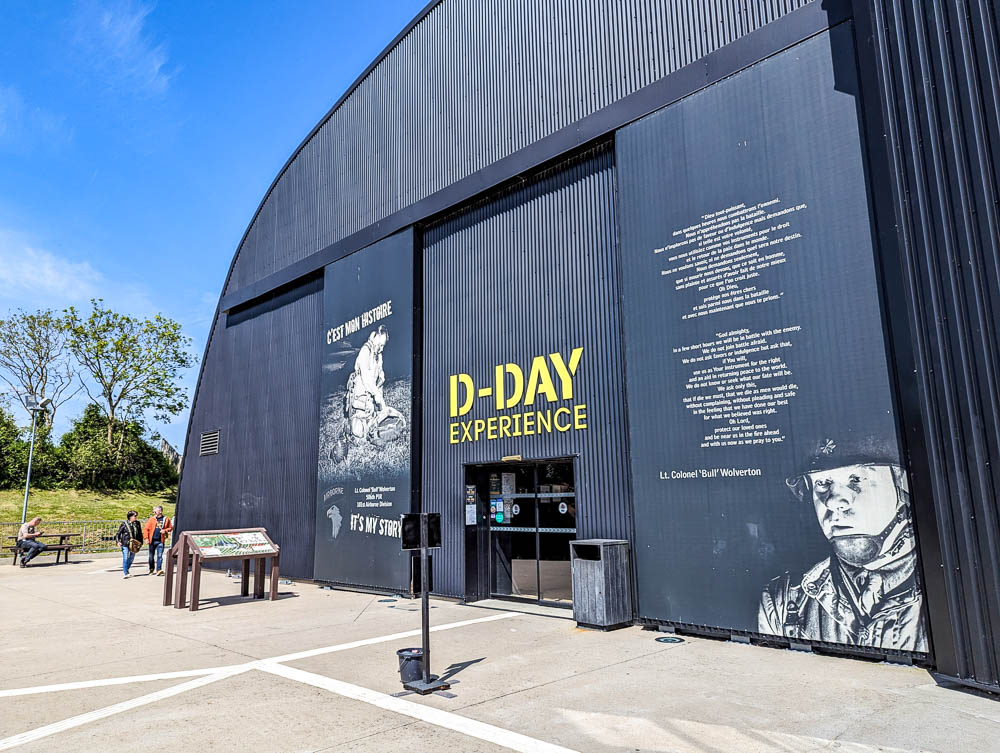
The C-47 simulator is interesting but wasn’t nearly as “exciting” as I thought it was going to be. However, I really enjoyed the presentation beforehand where you relive D-Day preparations with Lieutenant Colonel Robert Lee Wolverton.
Next, you board a genuine C-47 and, through video installations and other tech, fly over the English Channel to Normandy, get shot at, and eventually crash. While it’s meant to leave you with a truly harrowing account of flying into Normandy, the terror of it all is wildly toned down and feels more like a cheap carnival ride. (Curb your enthusiasm, that’s all I’m saying. It only lasts 4 minutes.) Still, you do get a bit of a sense of what it’s like to fly in a C-47 in a less-than-hospitable environment, and for that it’s worth the few extra bucks.
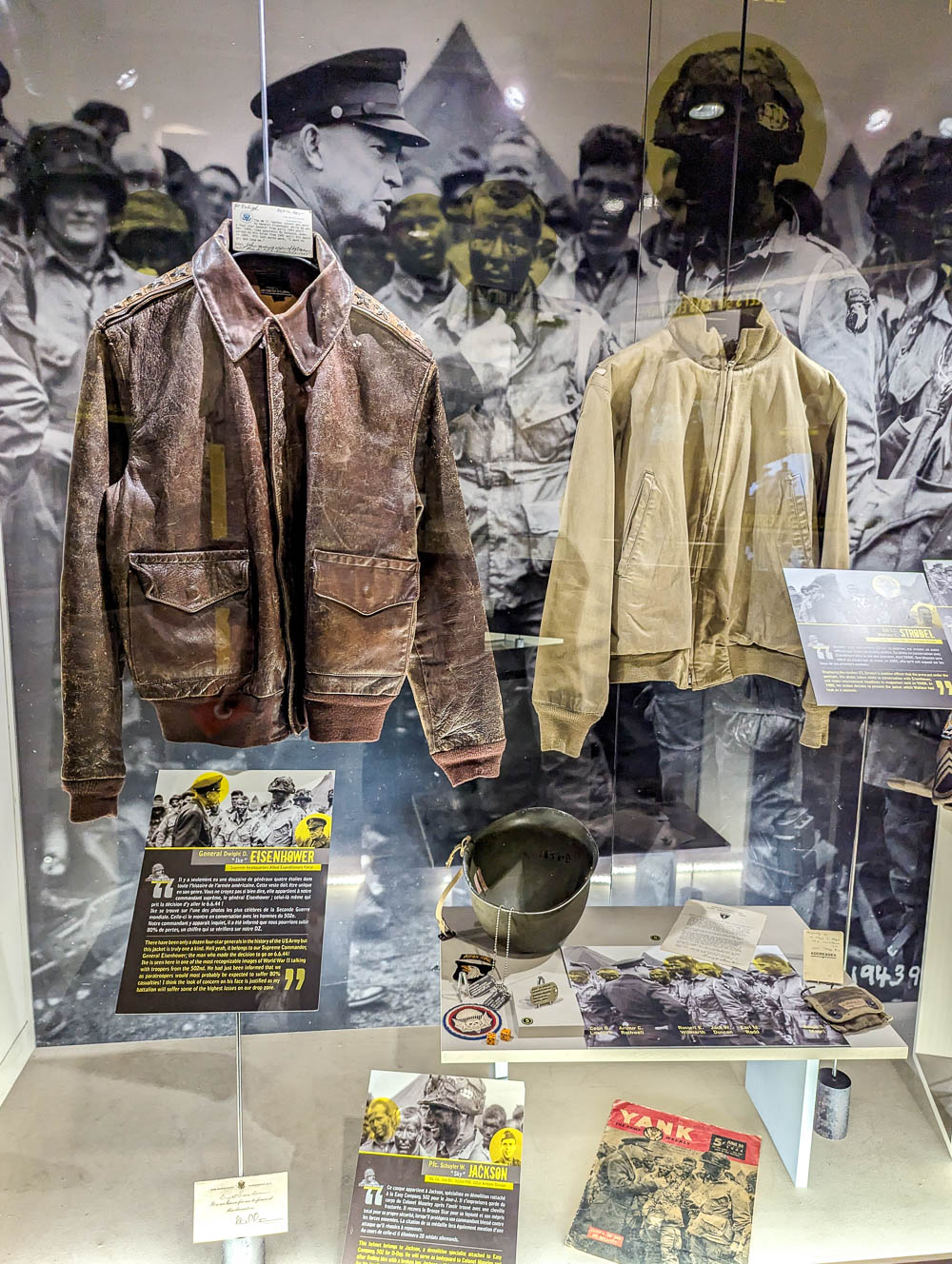
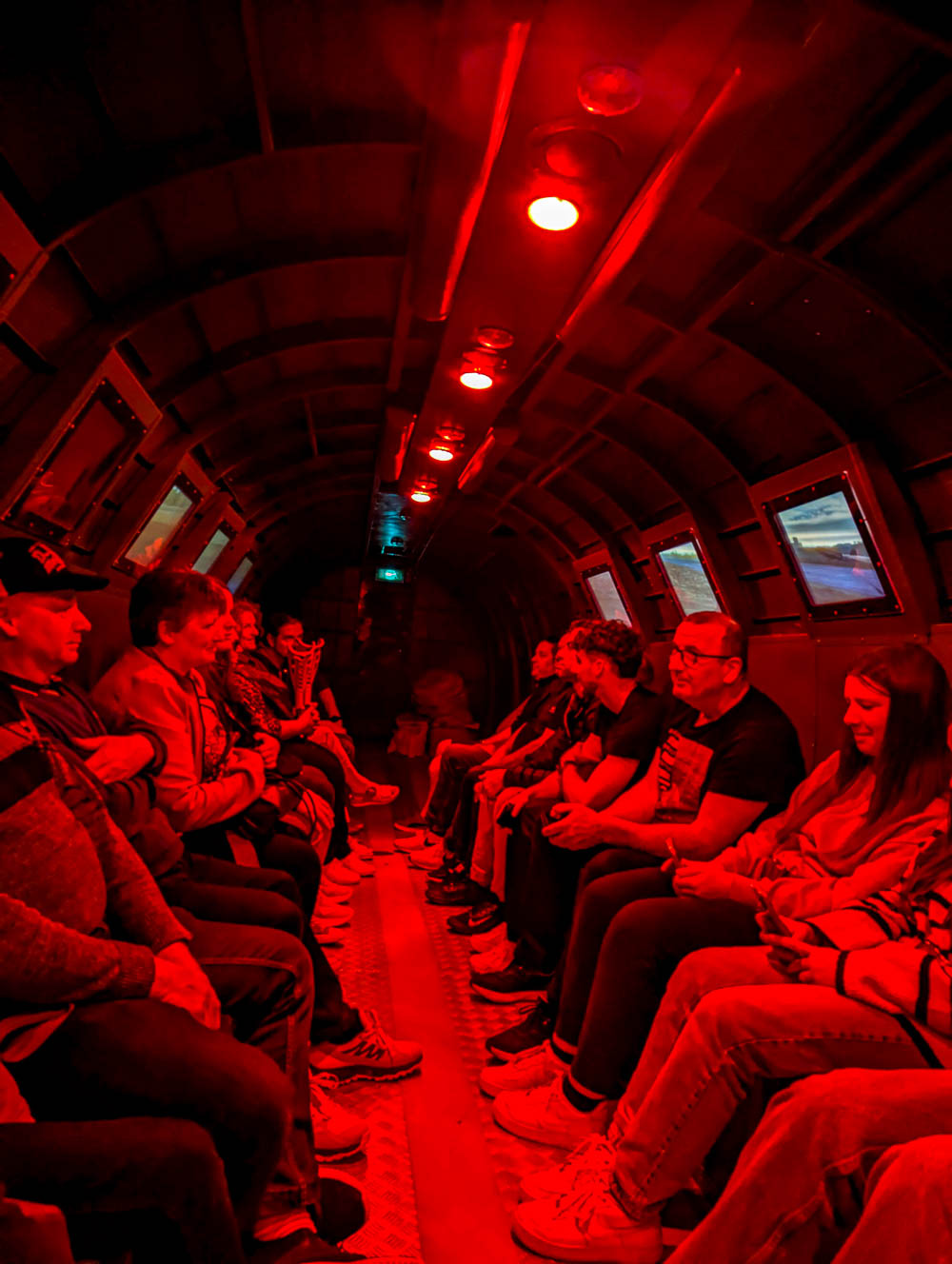
18. Dead Man’s Corner
This small museum is located in the former headquarters of the 6th German parachute infantry regiment. Today, the museum at Dead Man’s Corner is dedicated to the American paratroopers who took it over. You’ll find loads of genuine historical artifacts here all relating to how the building was used at the time and to those involved.
This museum is pretty small so it won’t take you long to explore. It’s located just outside the D-Day Experience museum and admission to Dead Man’s Corner is included with your D-Day Experience ticket.
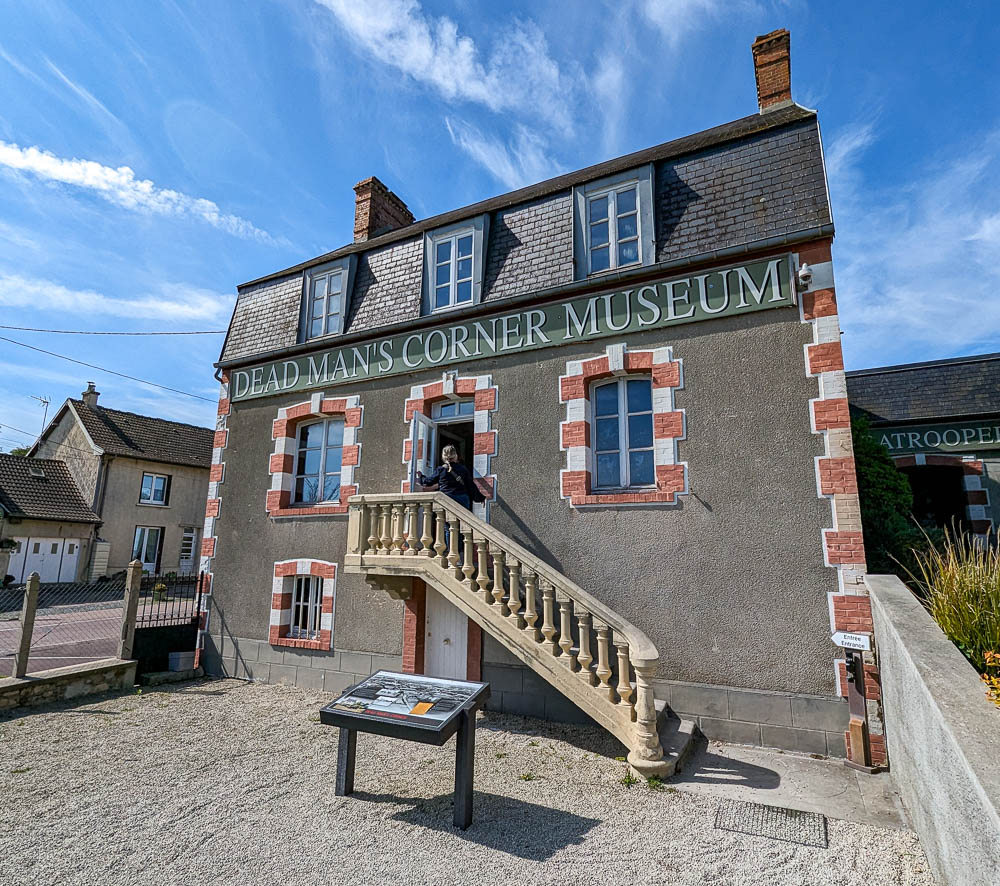
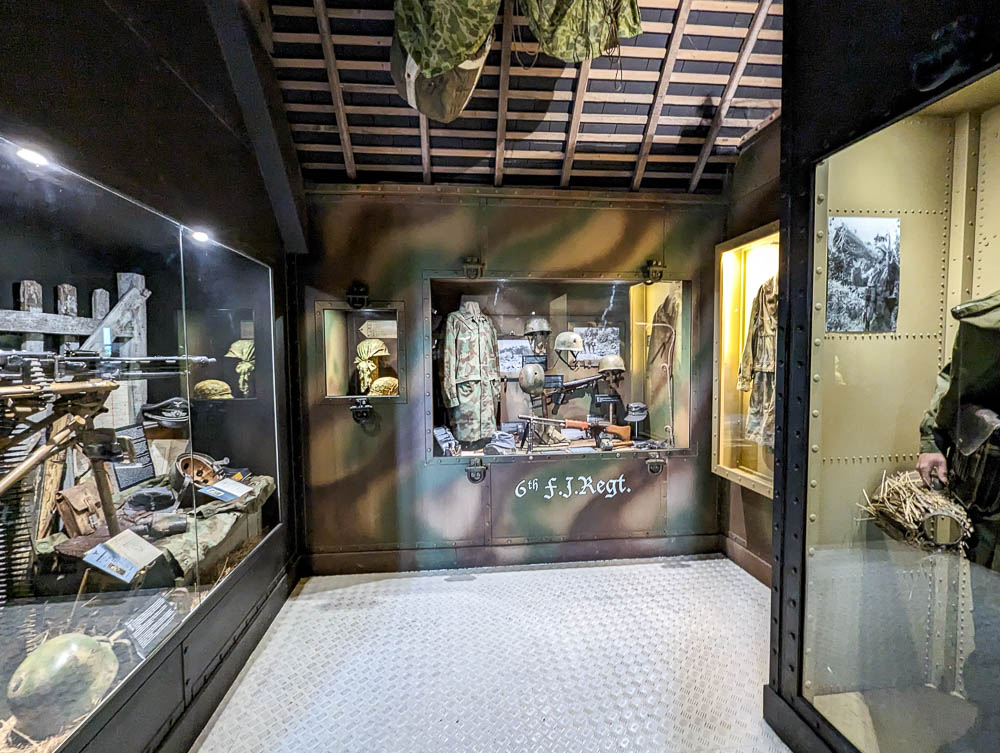
19. Liberty Road Marker Km00
This road marker denotes the beginning of the Liberty Road, a commemorative route following the path of Allied forces from D-Day onwards.
The Liberation Route begins in Normandy, continues on through northern France, and eventually ends in Bastogne near the Belgium/Luxembourg border. A stone marker like this one marks every kilometer along the way, totaling 1,147 of them. (See the last one here in my post on WWII sites in Belgium.)
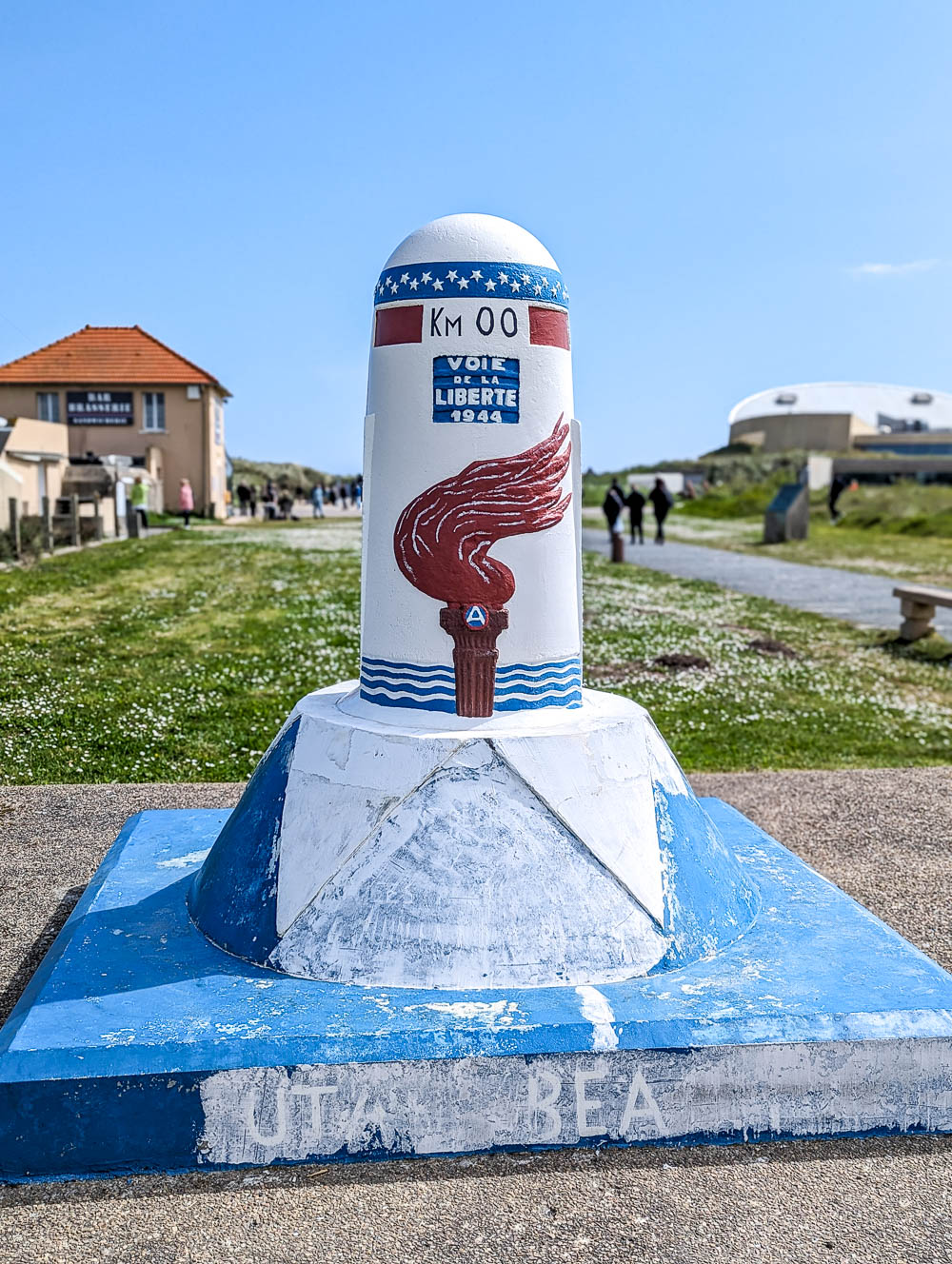
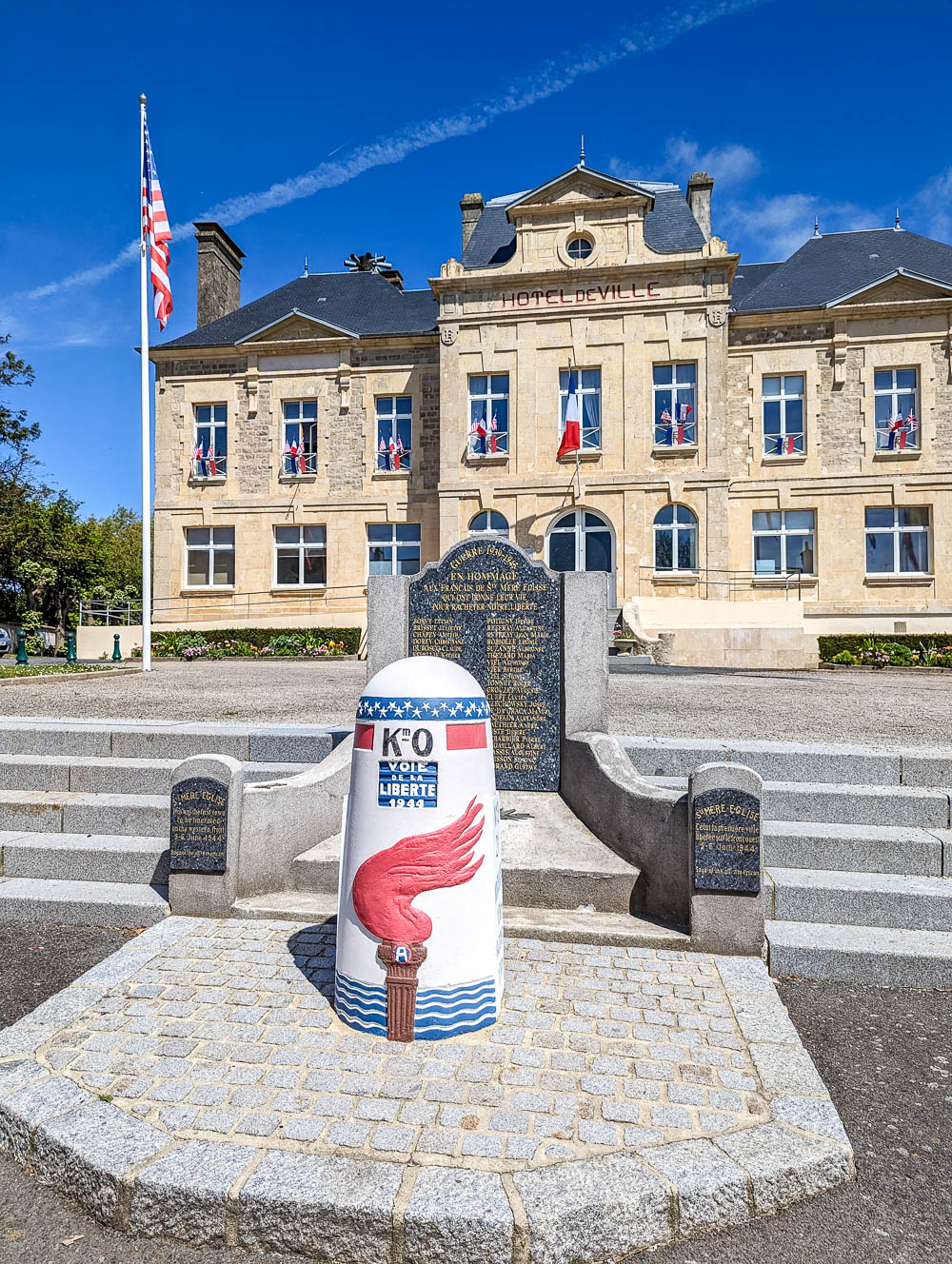
There are two Km00 markers—one at Utah Beach and one at Sainte-Mère-Église. Utah Beach is where liberating troops first landed, but Sainte-Mère-Église was the first town actually liberated by Allied troops. So, choose your own adventure, I guess!
The design is meant to represent the torch of liberty rising from the sea and being carried eastward. The top is lined with 48 stars representing the 48 US states (at the time). This route officially opened in 1947 making it the first French monument to the contributions of American troops.
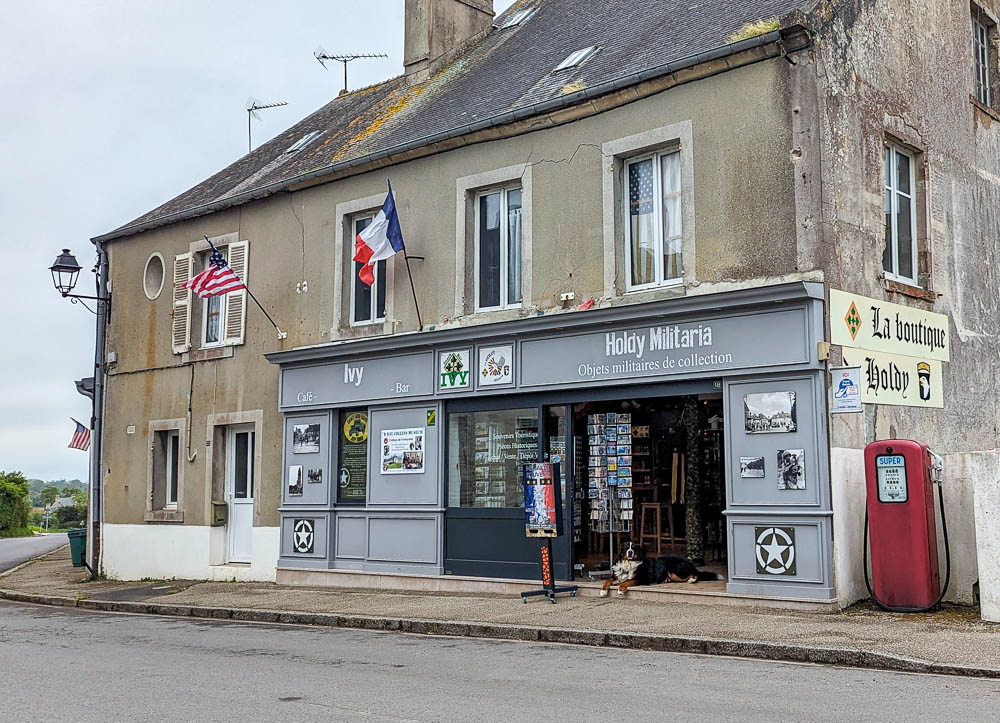
20. Le Holdy Militaria
Just past the Easy Company and Major Winters monuments, in the center of Sainte-Marie-du-Mont, is Le Holdy Militaria, the oldest military store in France.
Le Holdy is more than a souvenir shop; it’s a place to get 100% authentic pieces from World War II including uniforms, headwear, vehicle equipment, decorations, and more from German, French, American, Canadian, and British armies.
Who wants a keychain when you can get an original battle-worn helmet with a picture of the soldier wearing it in WWII? (But yeah, you can get keychains too.) They also sell accurate reproductions of pieces for reenactments or just plain ol’ collecting. You can also purchase modern souvenirs, clothing, movies, books, and they can even appraise your own pieces while you shop.
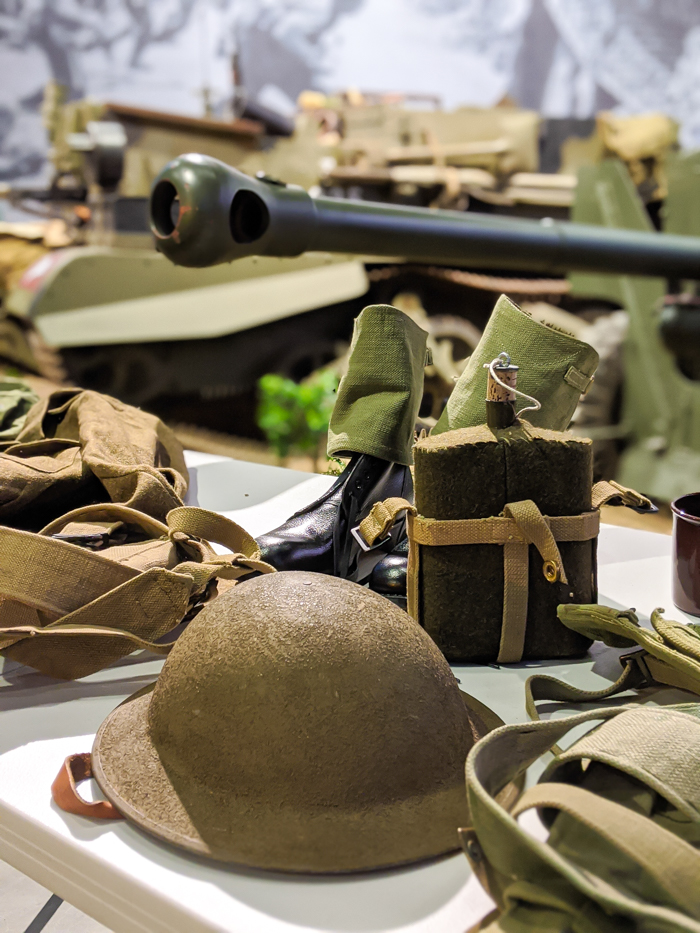
21. Airborne Museum
Like many of the WWII sites around these parts, the Airborne Museum is dedicated to the US paratroopers of the 82nd and 101st Airborne Divisions, but on a much larger scale. (This is a popular museum so be prepared for a slow-moving ticket line. Yes, even if you buy your tickets online ahead of time.)
This museum comprises three separate buildings, two of which resemble open parachutes. Inside you’ll find an incredible collection of WWII aircraft including:
- A rare WACO CG-4 glider (the only one of these on display in France)
- Douglas C-47 Skytrain
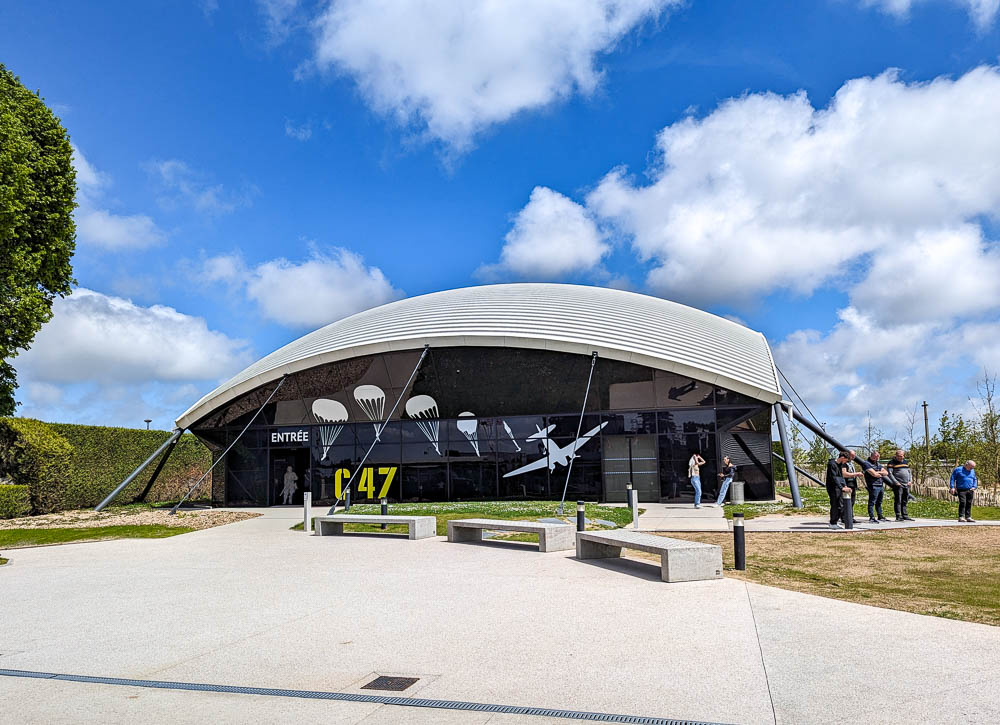
There are also several immersive exhibits, a ton of historical artifacts, and the free use of a “histopad” to provide you with all kinds of additional information and details as you tour the museum. Read more about the Airborne Museum in my post on the best Normandy WWII museums.
You’ll need to pay to park in the small public square, but you can visit all of Sainte-Mère-Église’s landmarks and other sites from here. Fair warning: There’s only ONE parking payment machine. If you visit on a busy day, chances are you’ll have to wait in a line while everyone in front of you tries to figure out how to use it. Plan accordingly! Pro tip: Take a picture of your license plate and have it ready when you get to the machine.
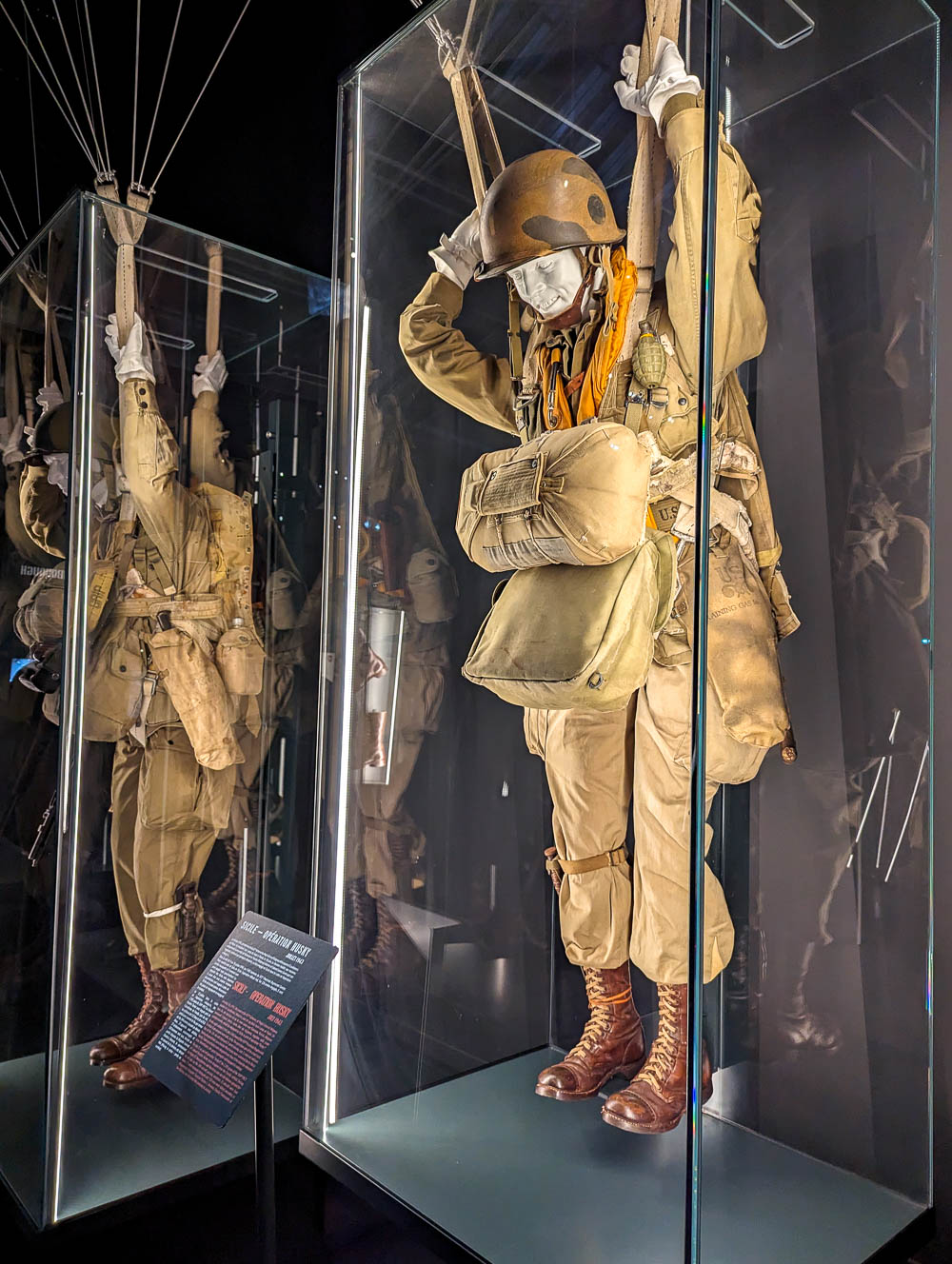
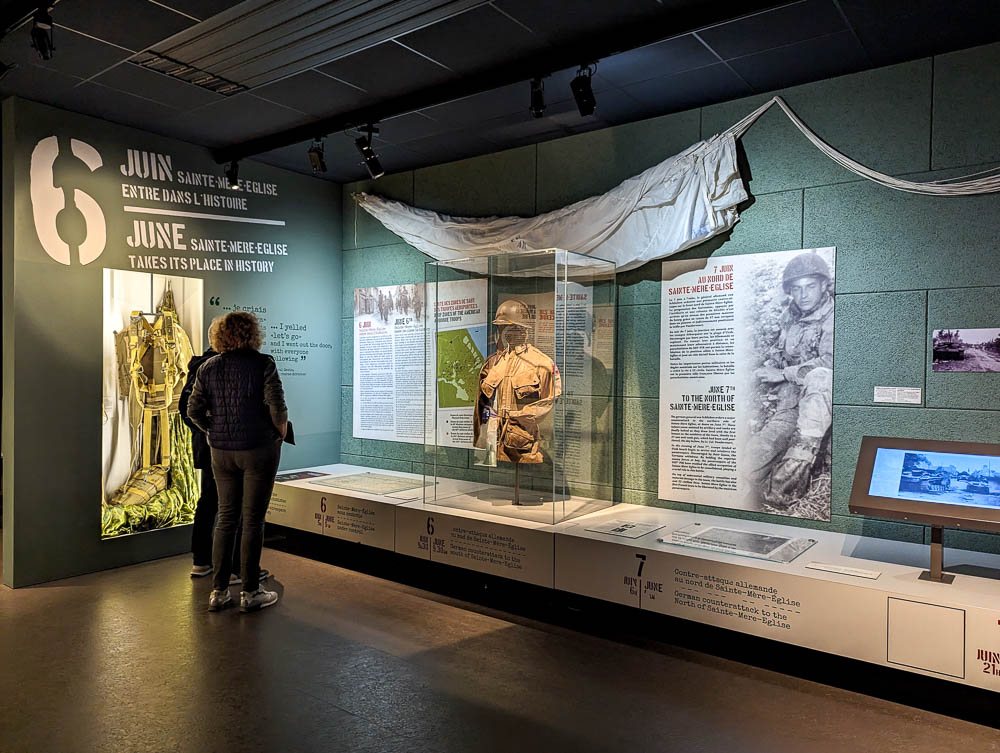
22. Church of Sainte-Mère-Église
Directly across from the Airborne Museum is the Church of Sainte-Mère-Église which was made famous after paratrooper John Steele became suspended from its bell tower after dropping in on D-Day.
While floating to the ground, Steele’s parachute snagged on the church’s belfry. While fighting ensued below him, Steele hung limp from the side of the church and played dead for hours to avoid capture. German troops eventually discovered him alive and captured him, but he was able to escape and rejoin his division. His story is told in the movie The Longest Day.
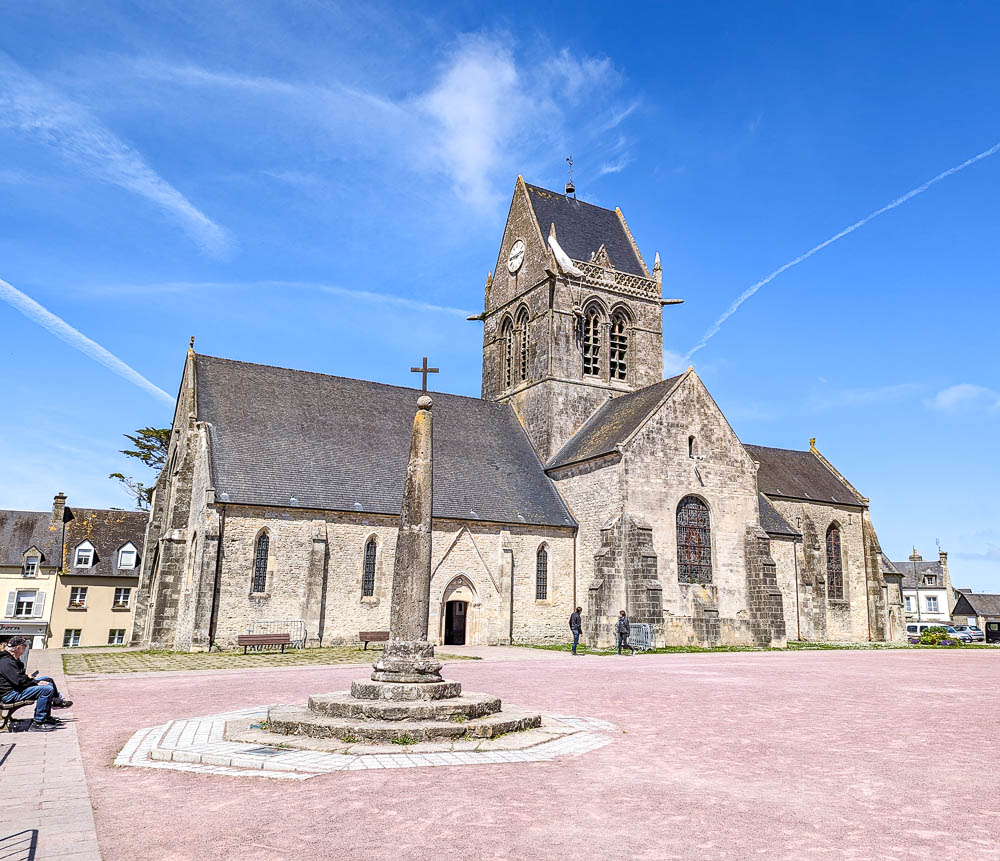
Today, the church memorializes him with a pretty unique monument—a statue of him hangs from a parachute caught on the church’s bell tower. Once inside, be sure to check out the stained glass windows which feature memorials to the Airborne divisions. The church is free to enter.
BONUS: Keep your car parked in the center and simply stroll the town center of Sainte-Mère-Église. You’ll find tons of war memorials here, plenty of interesting shops, several on-theme restaurants and cafés, and more.

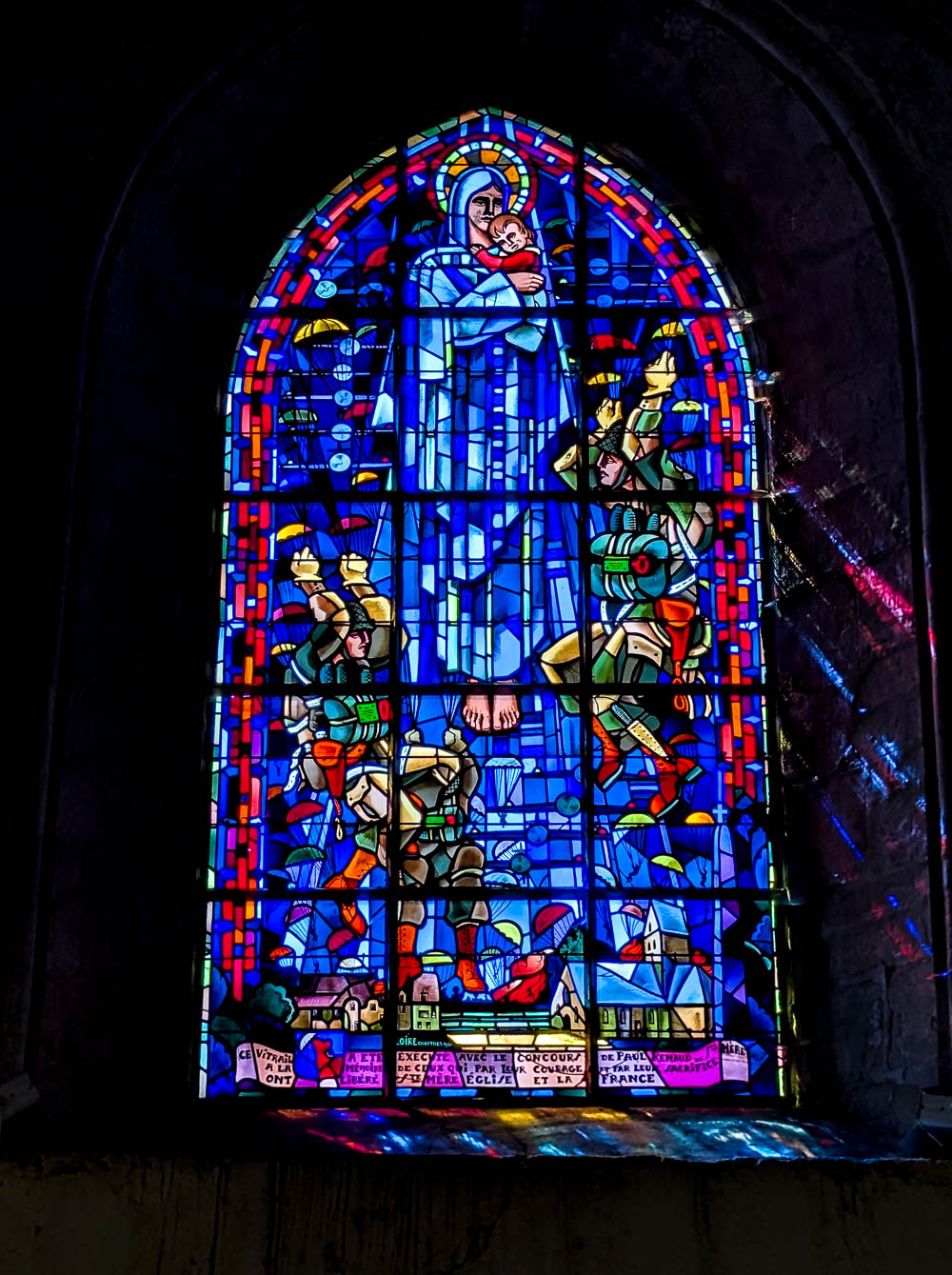
23. Airship Hangar
The Airship Hangar at Ecausseville was actually built by the French Navy way back in 1917 to search for German submarines during WWI. After the war, they abandoned the use of airships altogether.
After occupying France during WWII, Nazi Germany used the hangar to store equipment for the construction of its Atlantic Wall. Eventually, American troops took control of it and used it for storage and as a maintenance center for tanks and other vehicles.
Today, you can visit the Musée Hangar à Dirigeables d’Écausseville and learn all about the use of airships, the history of this particular aerobase, and see the incredible collection of French, German, British, and American graffiti inside this impressive structure.
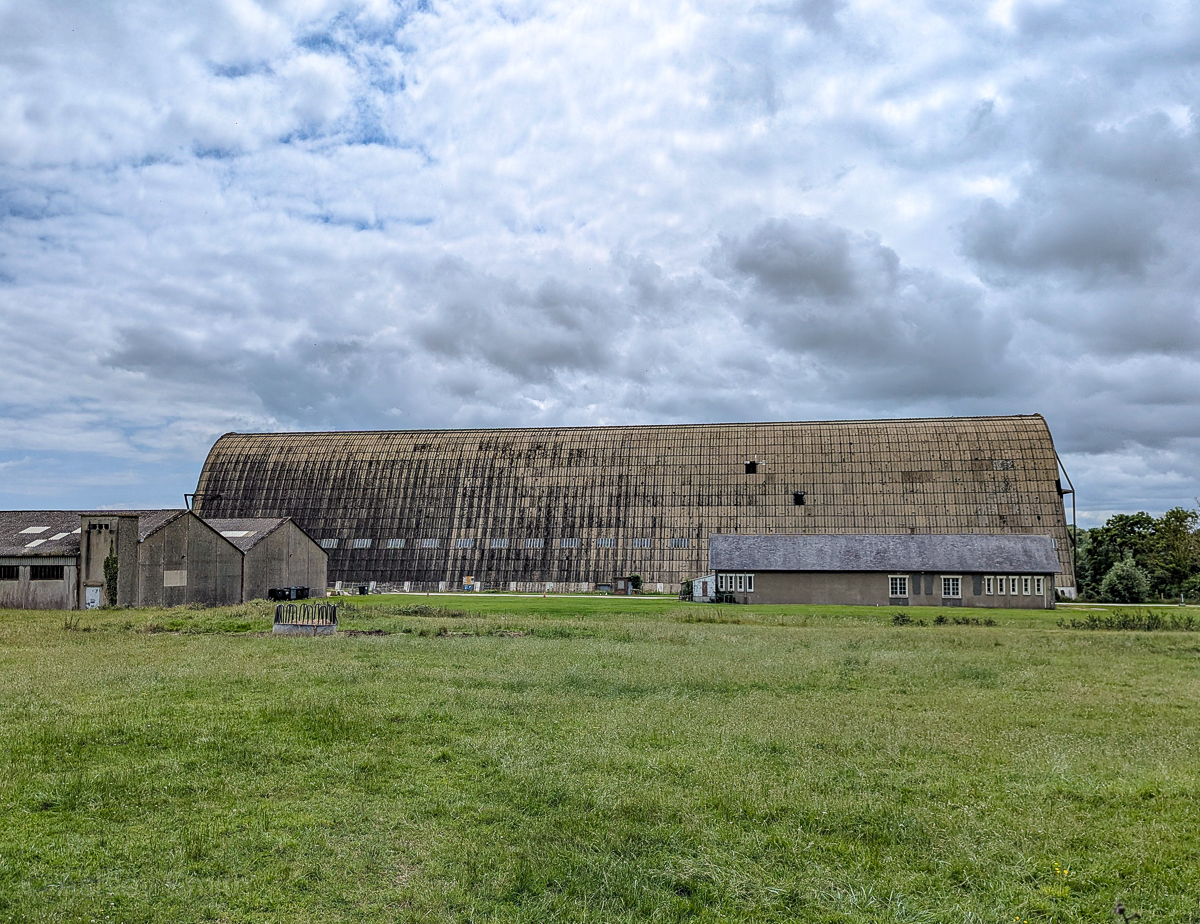
24. Église Saint-Côme-et-Saint Damien d’Angoville-au-Plain
In the commune of Angoville-au-Plain you’ll find the Church of Saints Cosmas and Damian. This small church served as an emergency hospital for two American soldiers on D-Day.
As soon as paratroopers landed, US Army medics Ken Moore and Robert Wright of the 101st Airborne Division set up an emergency first aid post inside the church. In total they rescued 81 wounded American and German soldiers.
Like the church at Sainte-Mère-Église, the stained glass windows here feature scenes relating to the events—one honors the two Army medics and the others honor the paratroopers. Bloodstains are said to also still be visible on some of the pews.
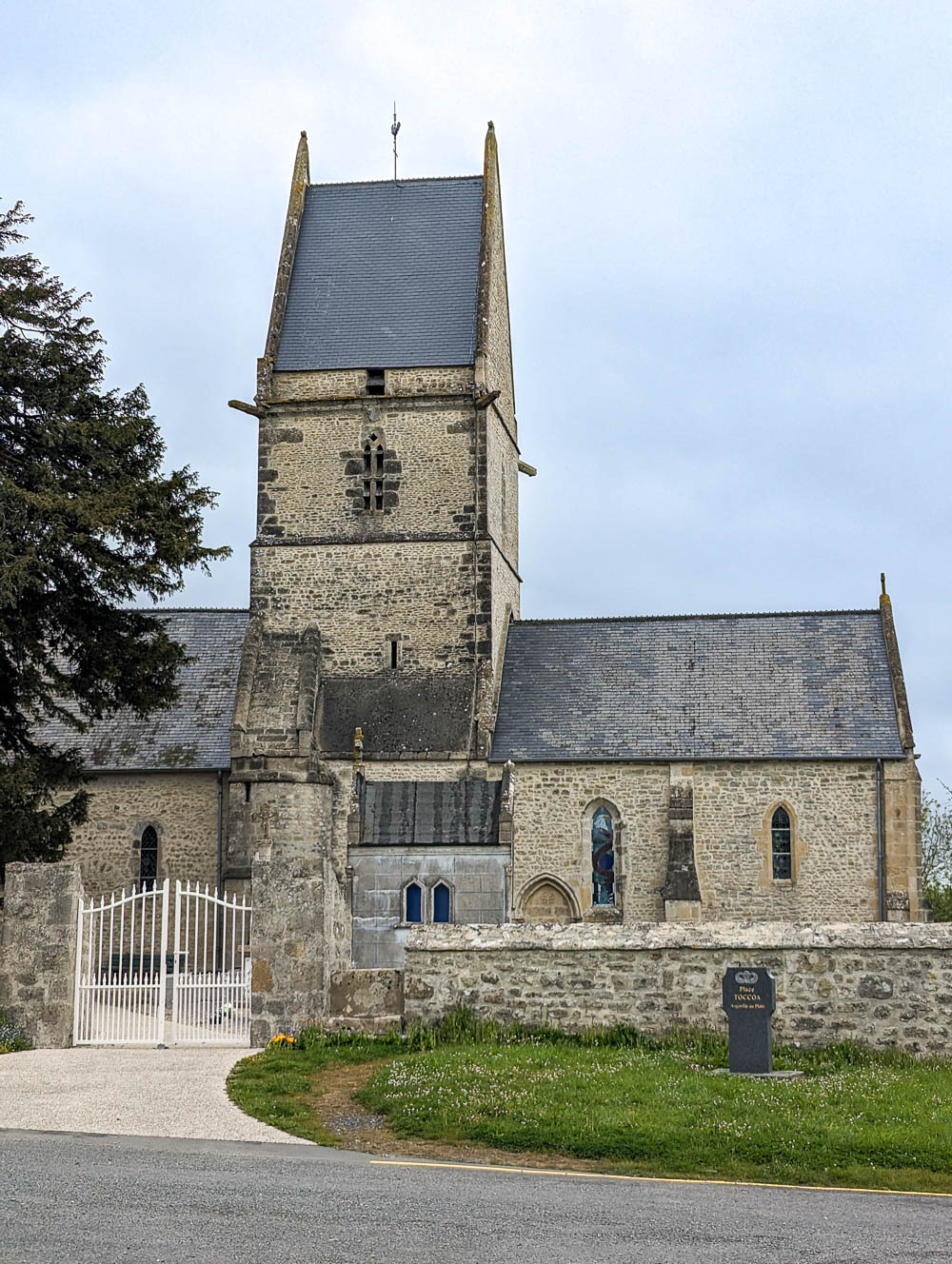
25. World War II Museum
At the far northern end of Utah Beach in the town of Quinéville you can visit the (generically-named) World War II Museum. This museum traces the “complete chronological journey of the Second World War in Normandy.”
Inside you can see a reconstructed street of homes and shops under Nazi occupation (complete with sound), hundreds of historical artifacts, a bunker, battle remnants and tanks outside, and a short film. This museum does a fantastic job of illustrating what life was like for the French during the initial German invasion, the entire Nazi occupation, D-Day, and more.
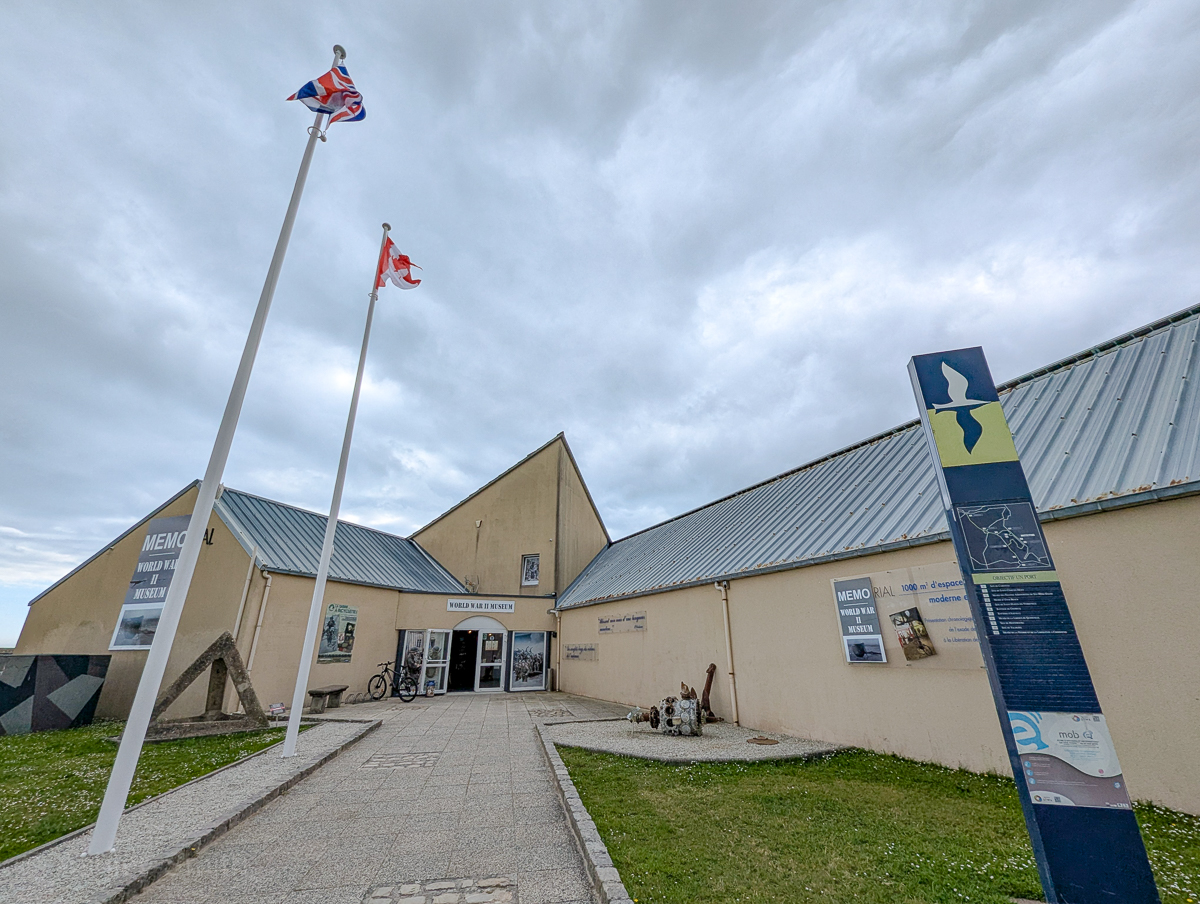
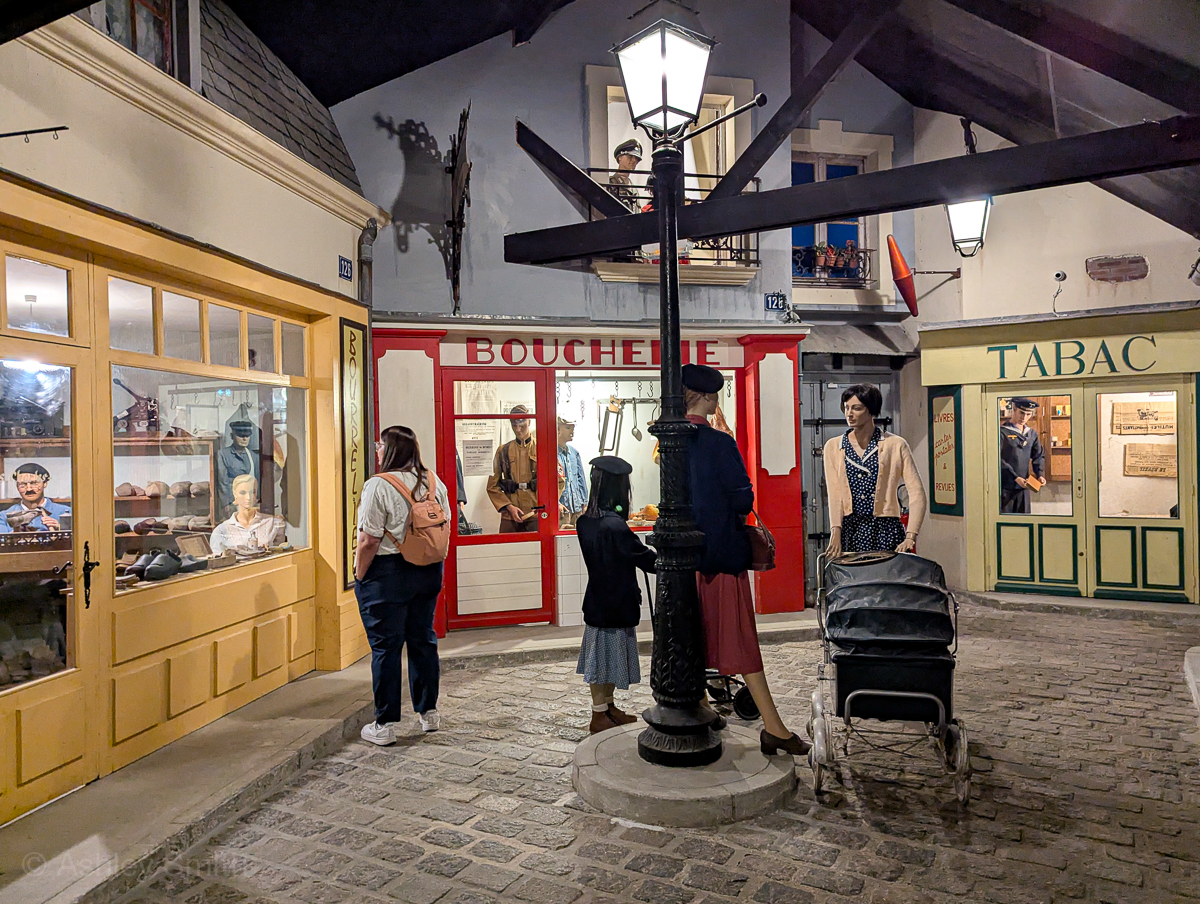
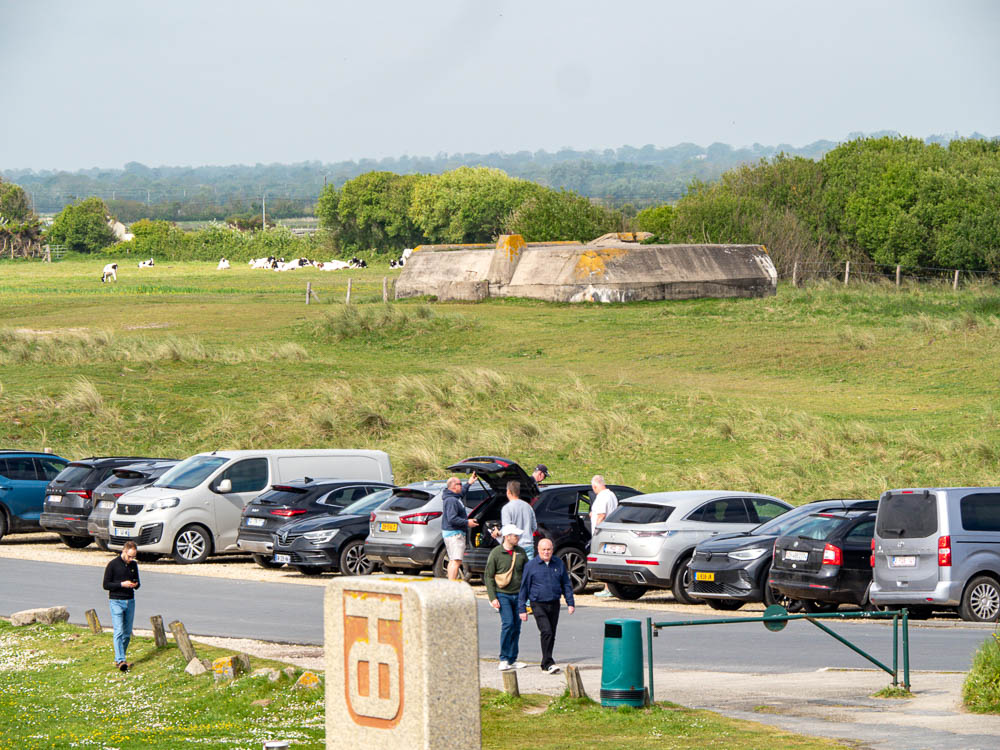
26. Miscellaneous war remnants
You can find more than just museums and memorials at Utah Beach. The entire area is still covered in remnants from the war much as they were left. Batteries, bunkers, tanks, boats, beach obstacles, and more. Be sure to keep your eyes open while exploring the Utah Beach sector; you never know what you’ll come across. Specifically, look for:
27. Azeville Battery
The Azeville Battery was one of the first Atlantic Wall constructions and today you can visit the battery itself and its 350m underground bunker. Your visit includes an awesome audio guide and you can tour the permanent exhibition and observe the daily life of the 170 German soldiers who used it.
Note that a great deal of your visit here will be spent either underground or otherwise down in the tunnel system which may not be for everyone. There are plenty of above-ground batteries and things to check out here too.
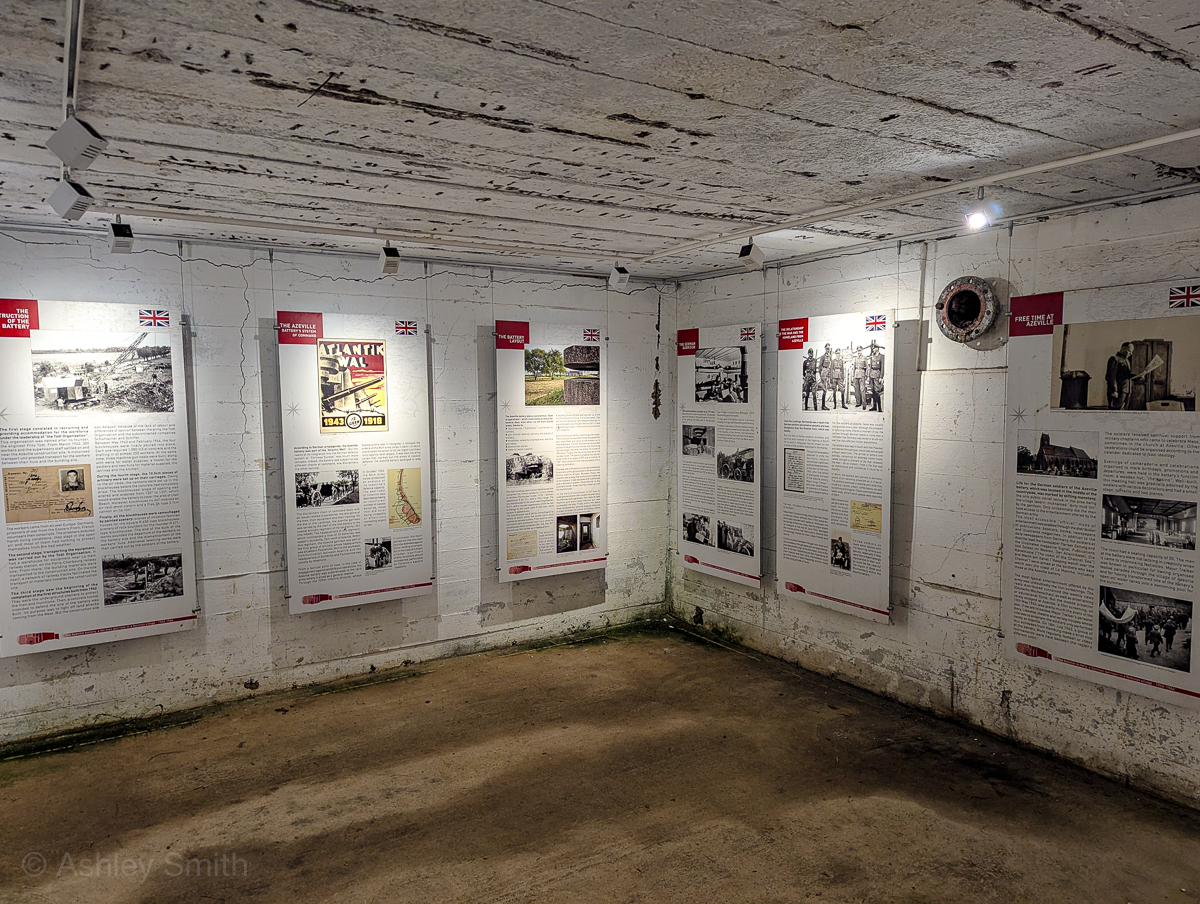
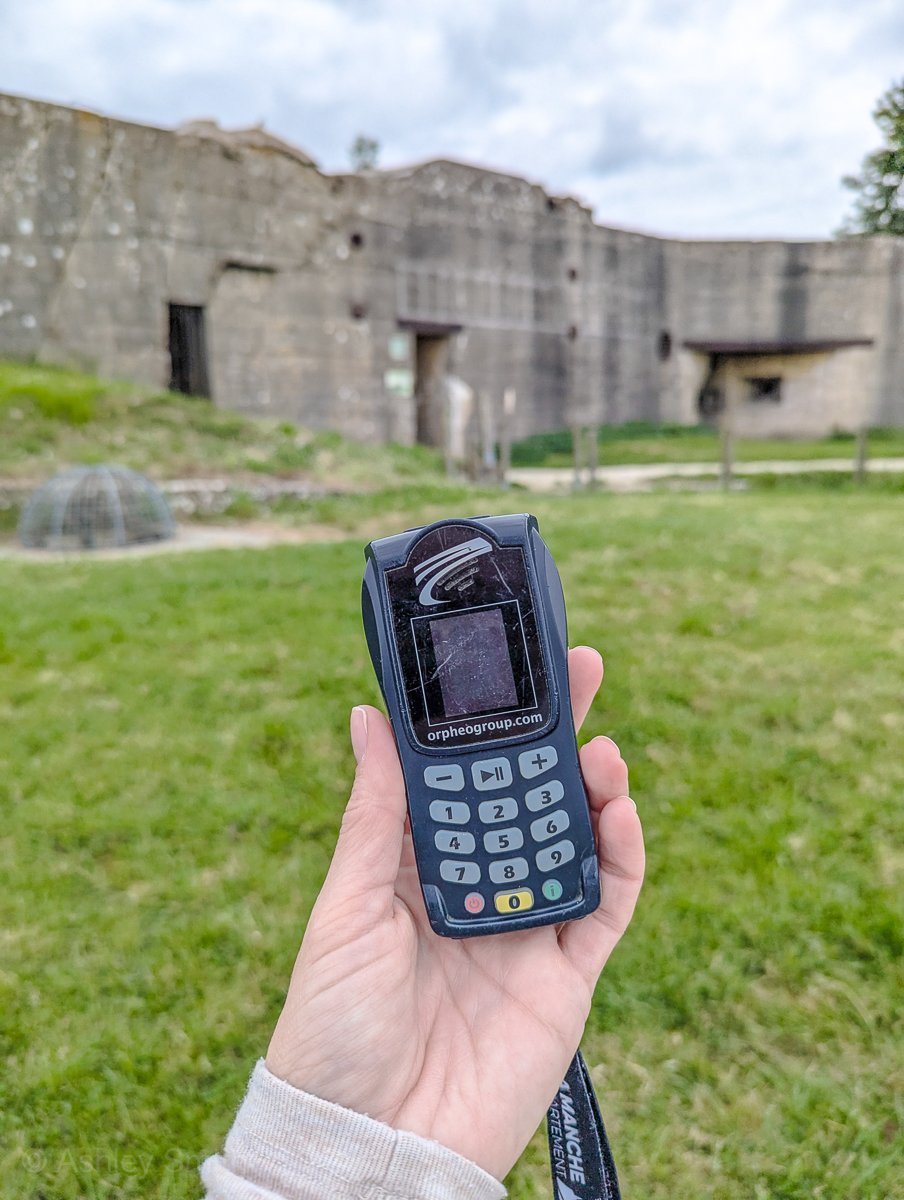
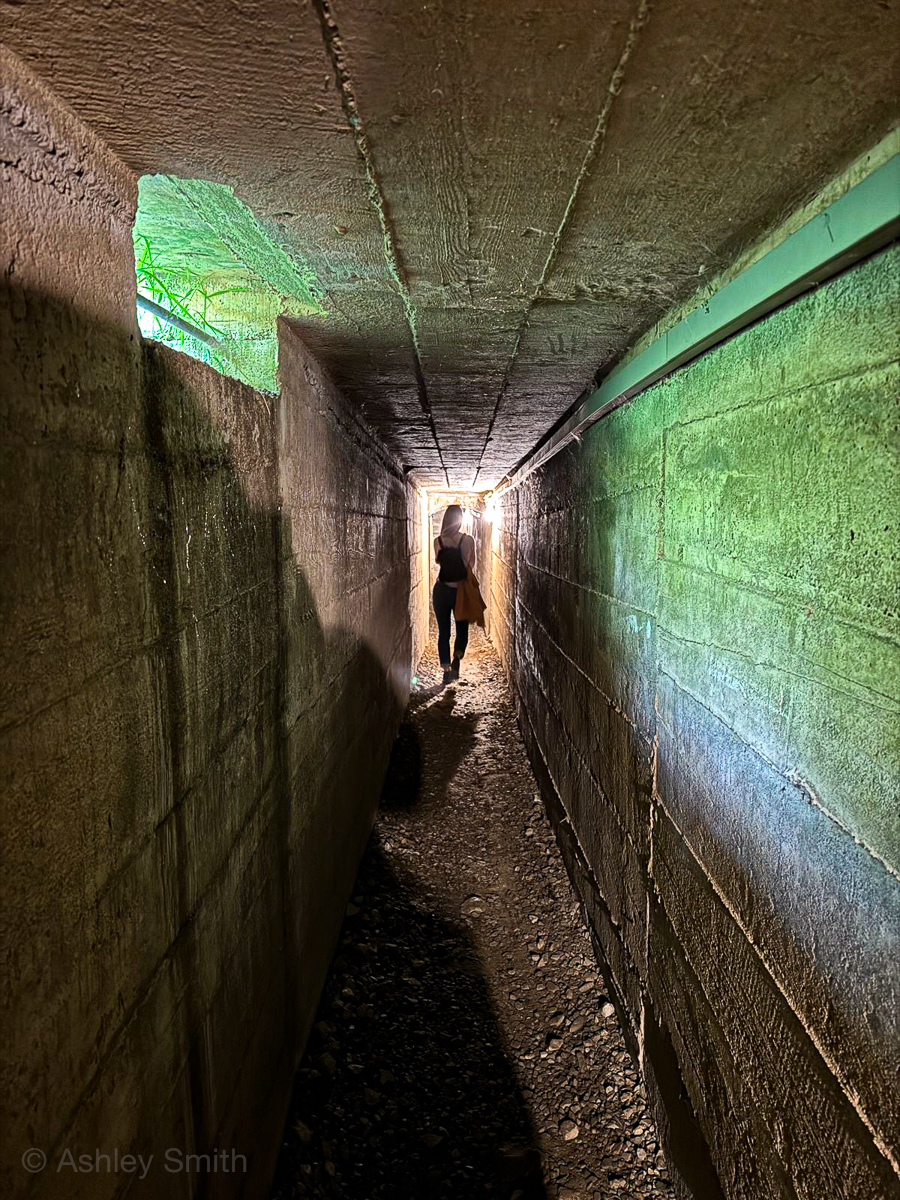
28. Crisbecq Battery
The Crisbecq Battery (often called the Marcouf Battery due to its location near the village of Saint-Marcouf) is said to have been one of the most powerful batteries in Normandy. Visiting today you’ll get to see many of its rooms, some that have been recreated with original equipment and others that remain in their original state.
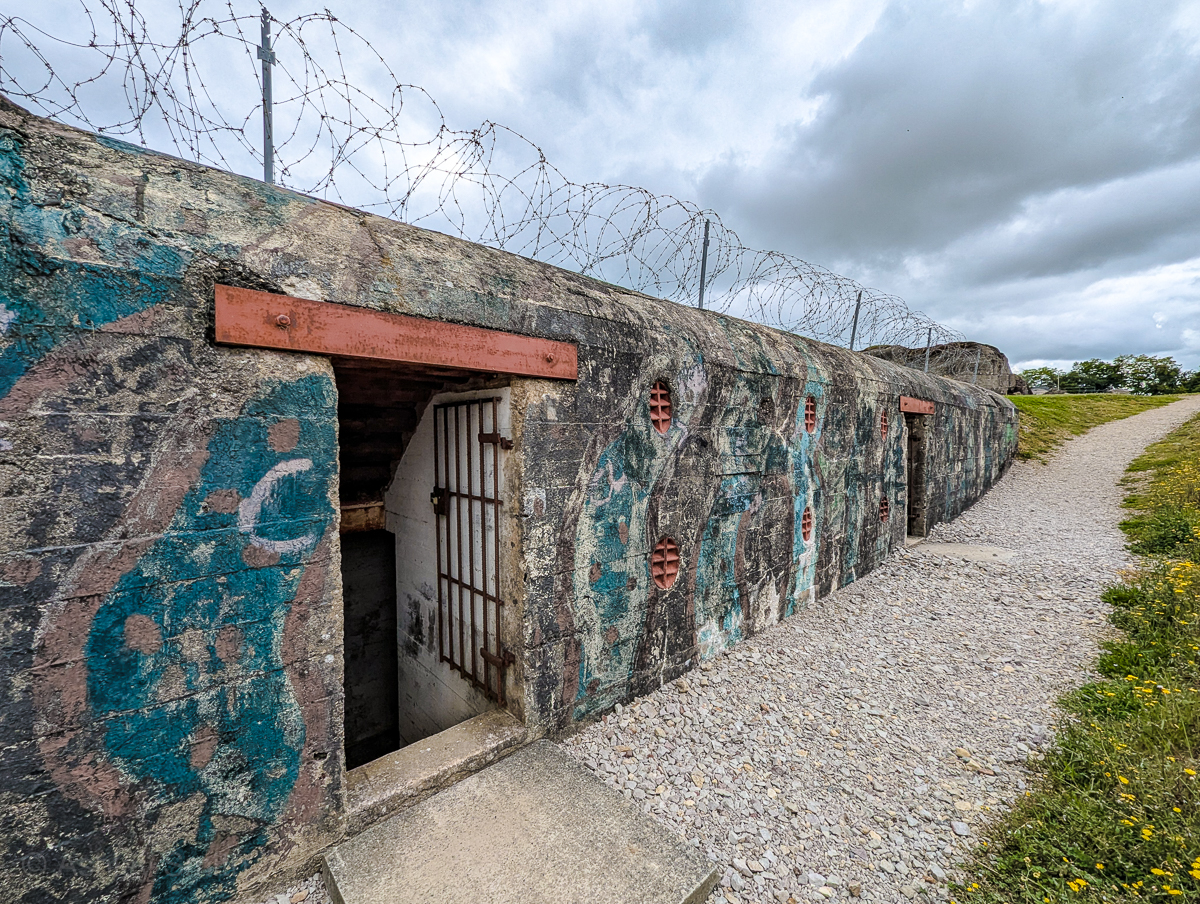
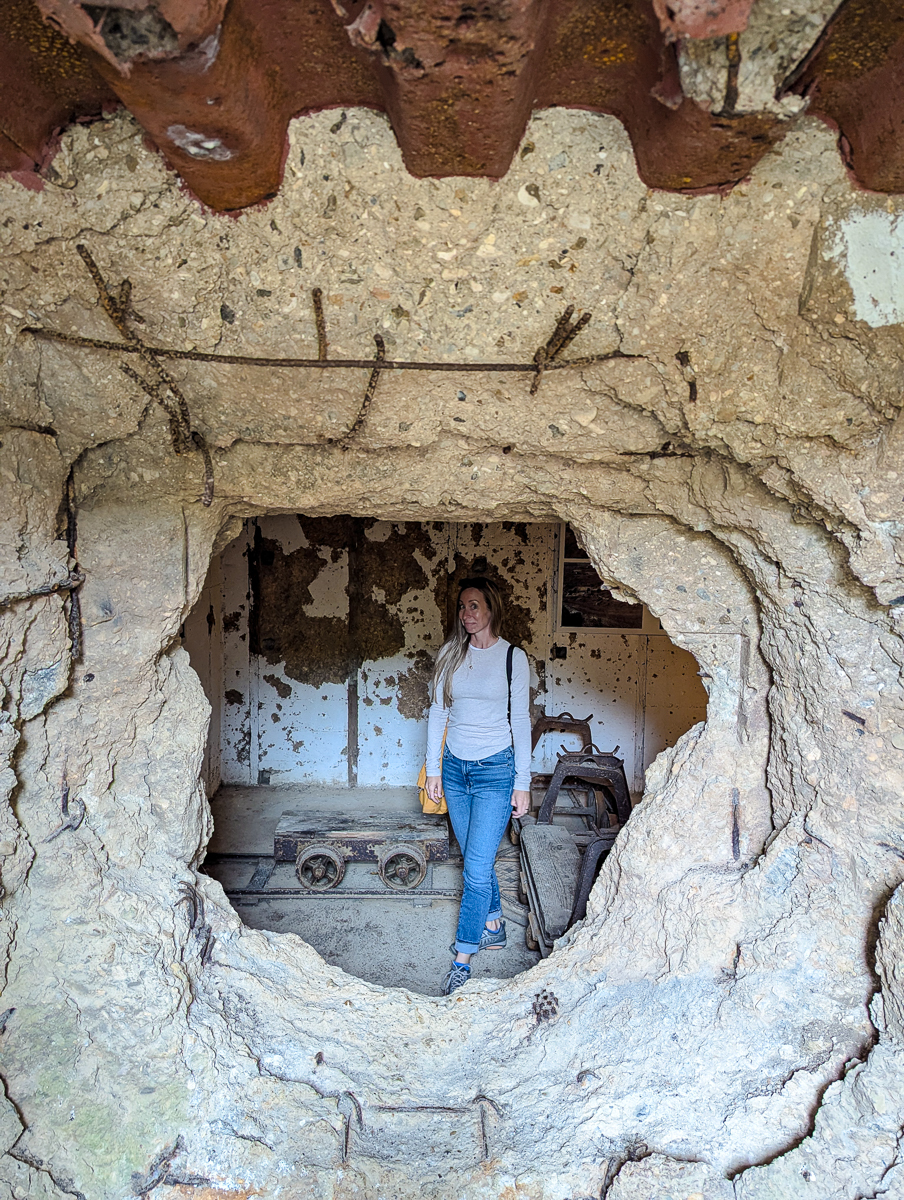
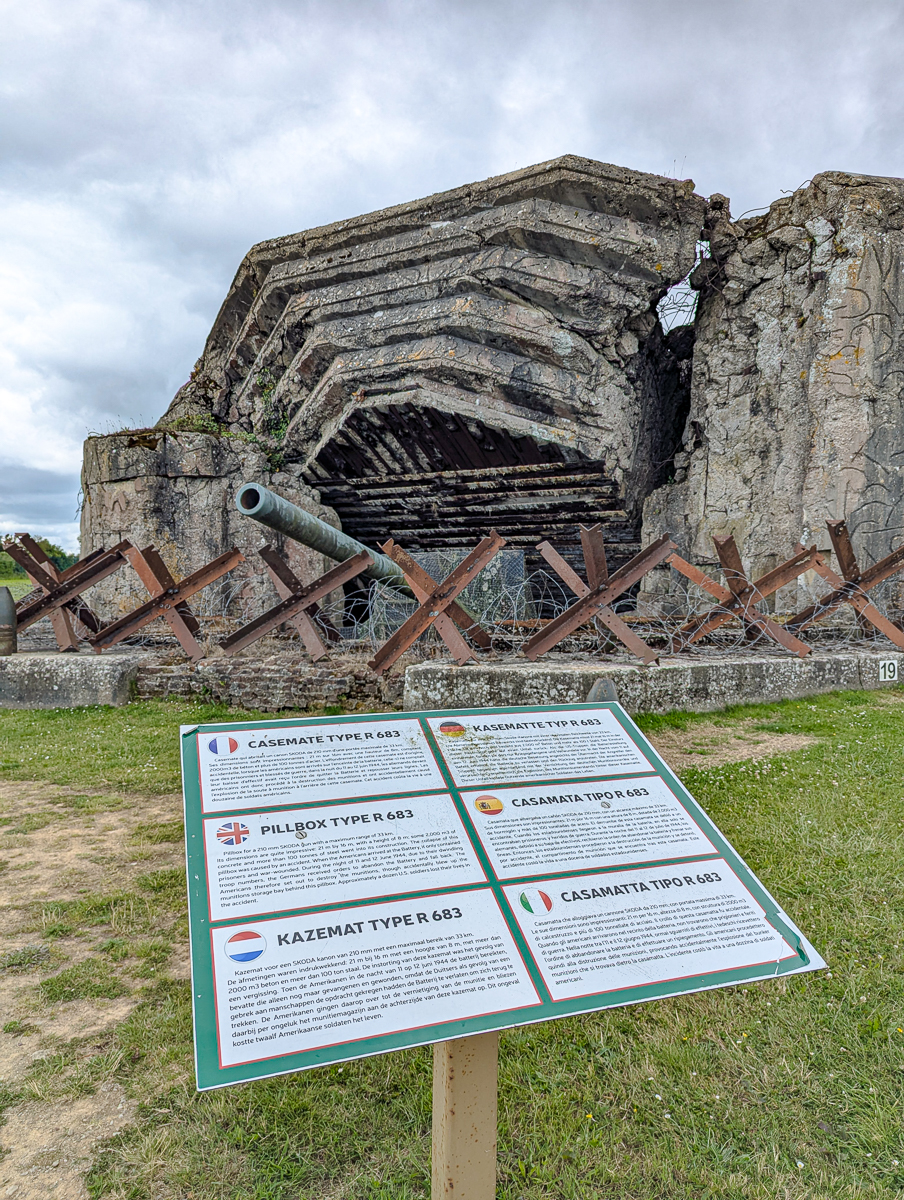
29. German bunkers
All around the Utah Beach area you’ll find the remains of several German artillery bunkers. Some, like the ones mentioned above, you can formally visit. Most of them however just sit here in various stages of decay.
You can check these out for yourself and without restriction, but please be careful! Don’t forget about that “various stages of decay” thing and maybe go ahead and get your tetanus booster?
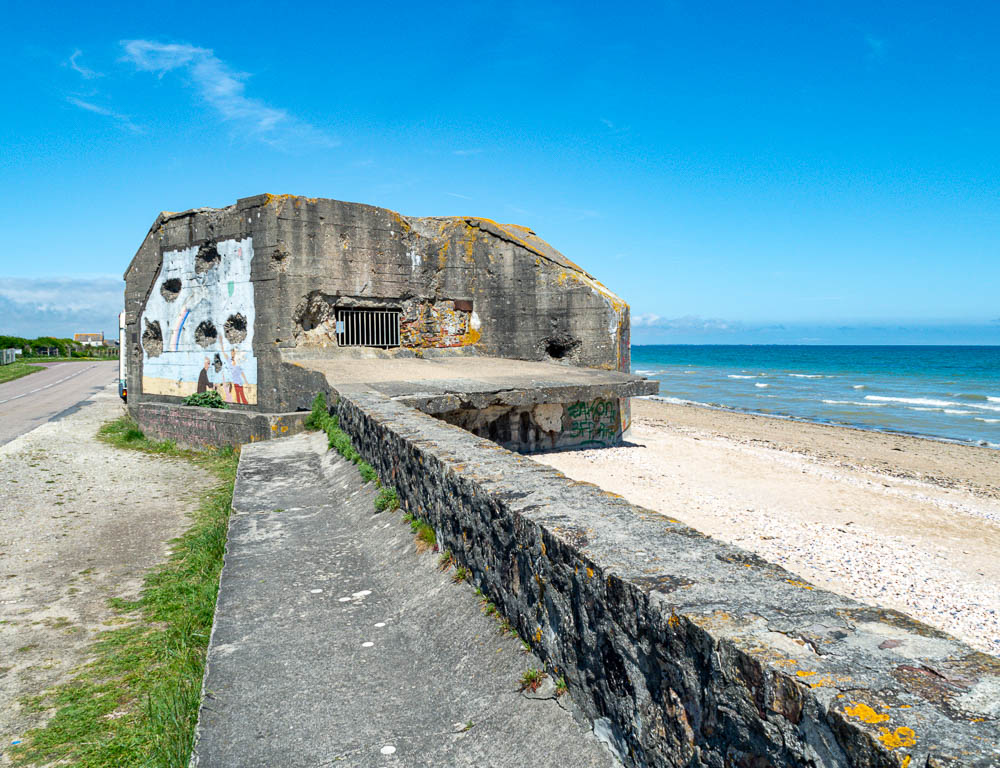
30. Easy Company Command Post
Just down the road from the Easy Company memorial is the building the 101st Airborne used as the temporary Easy Company command post during the Battle of Normandy. There aren’t any signs denoting this, but you’ll recognize it by the American flag that still hangs here. It was from here the 101st launched the assault on Brécourt Manor.
Keep in mind this building is still privately owned. Don’t attempt to go inside and do keep your distance when viewing from the street.
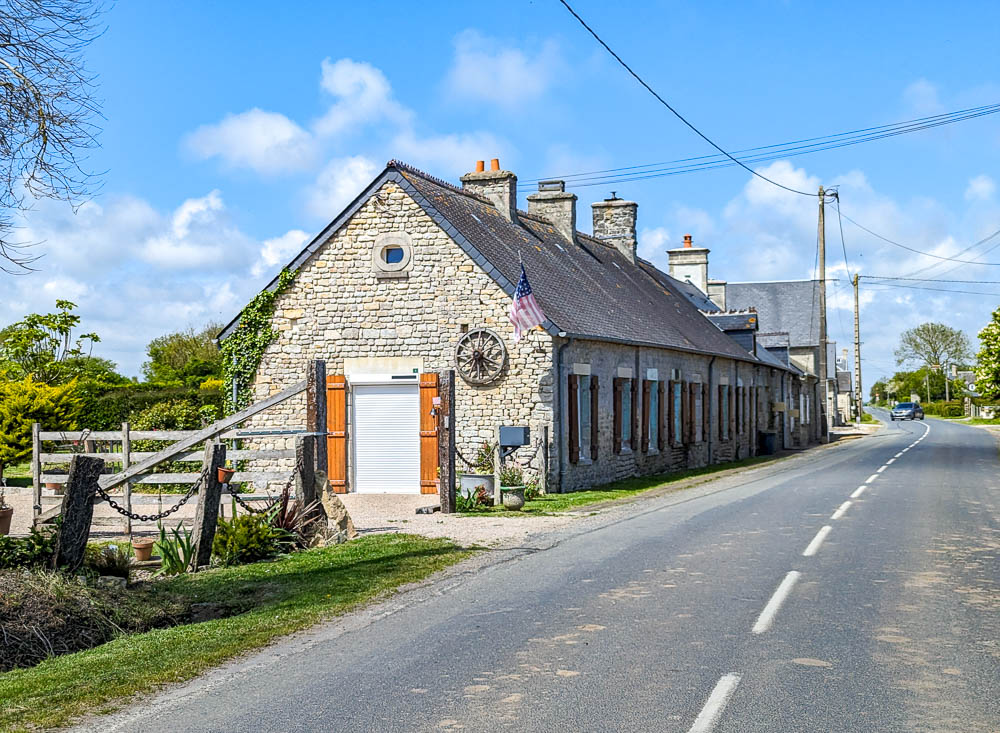
Special note about Brécourt Manor
The famous Brécourt Manor is also located on private property here and, as significant a location as it is, is therefore un-visitable. They do even have signs near the Easy Company memorial asking for privacy so please respect this!
31. The historic buildings in Sainte-Marie-du-Mont
Walking around the center of Sainte-Marie-du-Mont you’ll be able to get all the historical intel on the buildings here thanks to a series of informational plaques. Look for the numbered white French/English panels attached to the buildings here to learn some interesting information on how each of these locations was used during the war.
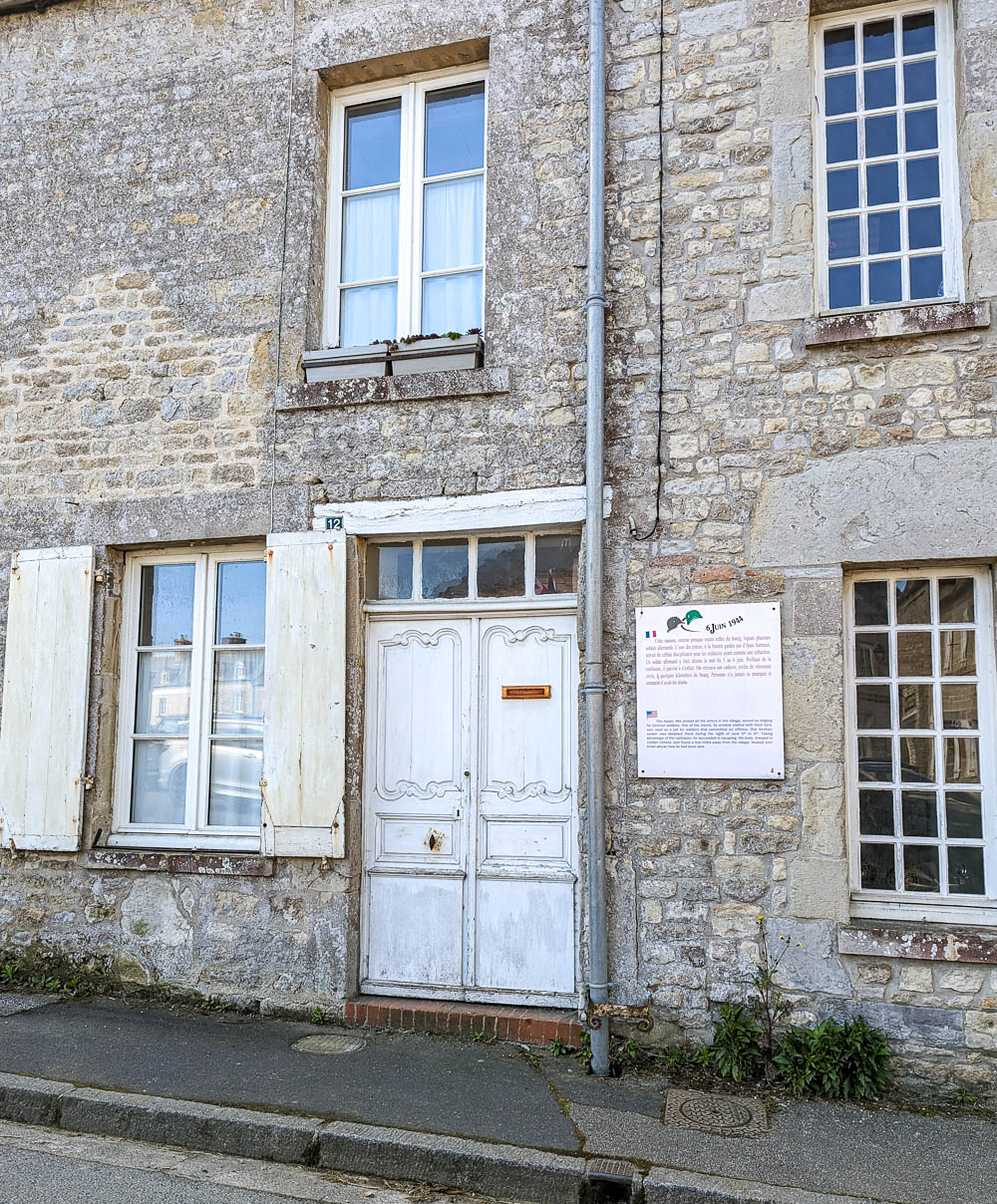
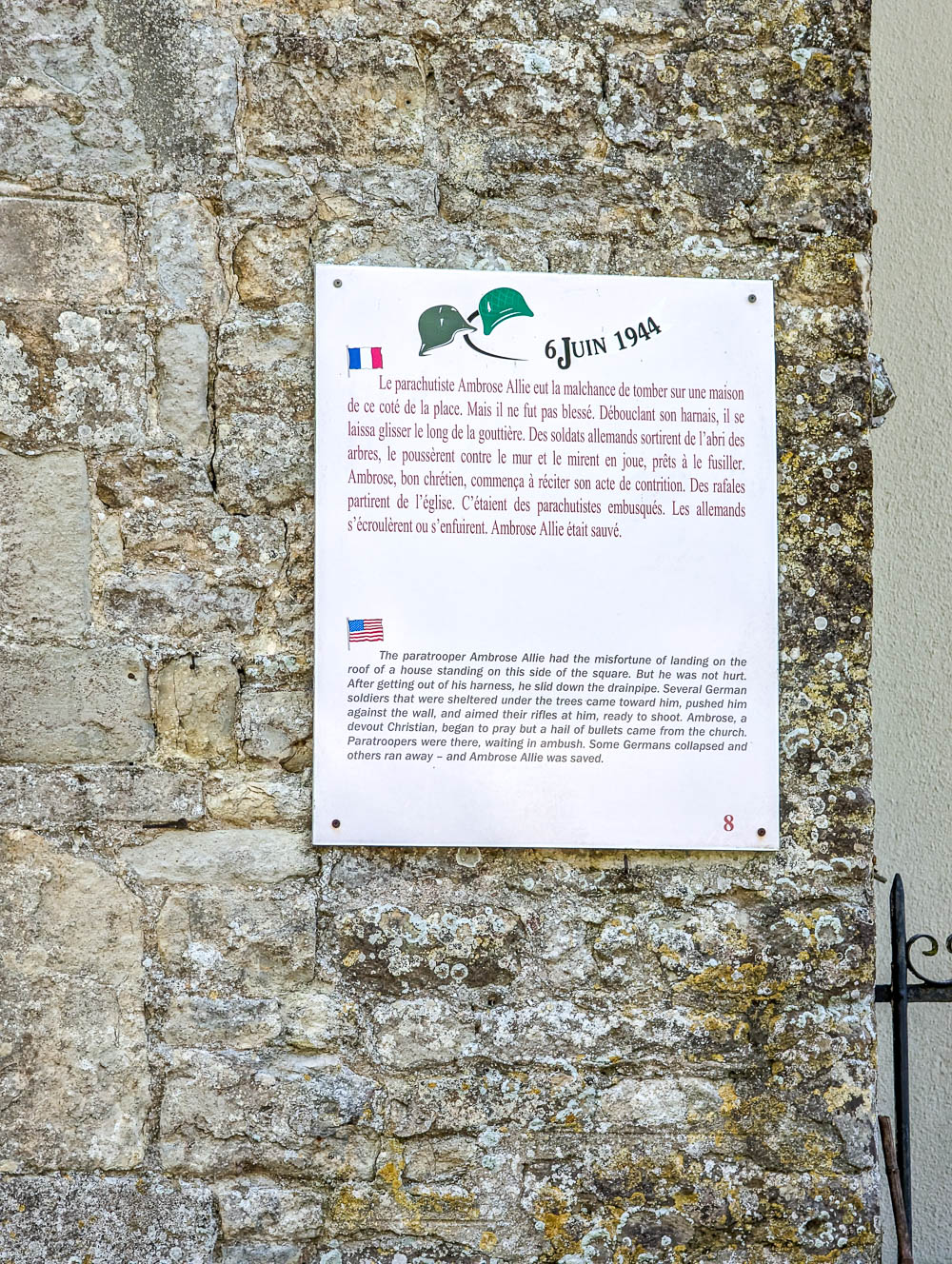
As far as reminders of the war go, you really won’t find any shortage here. You’ll notice as you drive along the beach and throughout the greater Utah Beach sector that war ruins abound! Whether it’s German bunkers, scattered beach obstacles, Sherman tanks (so many Sherman tanks!), you’ll have plenty to keep you busy.
You’re welcome to stop and check them out up close, just be mindful of where you park and whether the property you’re on is private or public.
Where to stay when visiting Utah Beach
If you’d like to base yourself in the Utah Beach sector during your Normandy visit, check out these great hotel options:
La Ferme Delaunay (Saint-Côme-du-Mont)
My personal favorite place to stay near Utah Beach is La Ferme Delaunay–an old farmhouse where an actual D-Day battle took place. Besides being an absolutely delightful bed & breakfast in a quiet area with spacious rooms, ample free parking, and two very lovely hosts, this building also has so much interesting history.
La Ferme Delaunay is super easy to get to and close to many of the WWII sites listed in this post (and others). It’s perfectly situated right between the Utah and Omaha Beach landing sectors. I stayed here myself in June 2025 and highly recommend it!
Book your stay here: La Ferme Delaunay
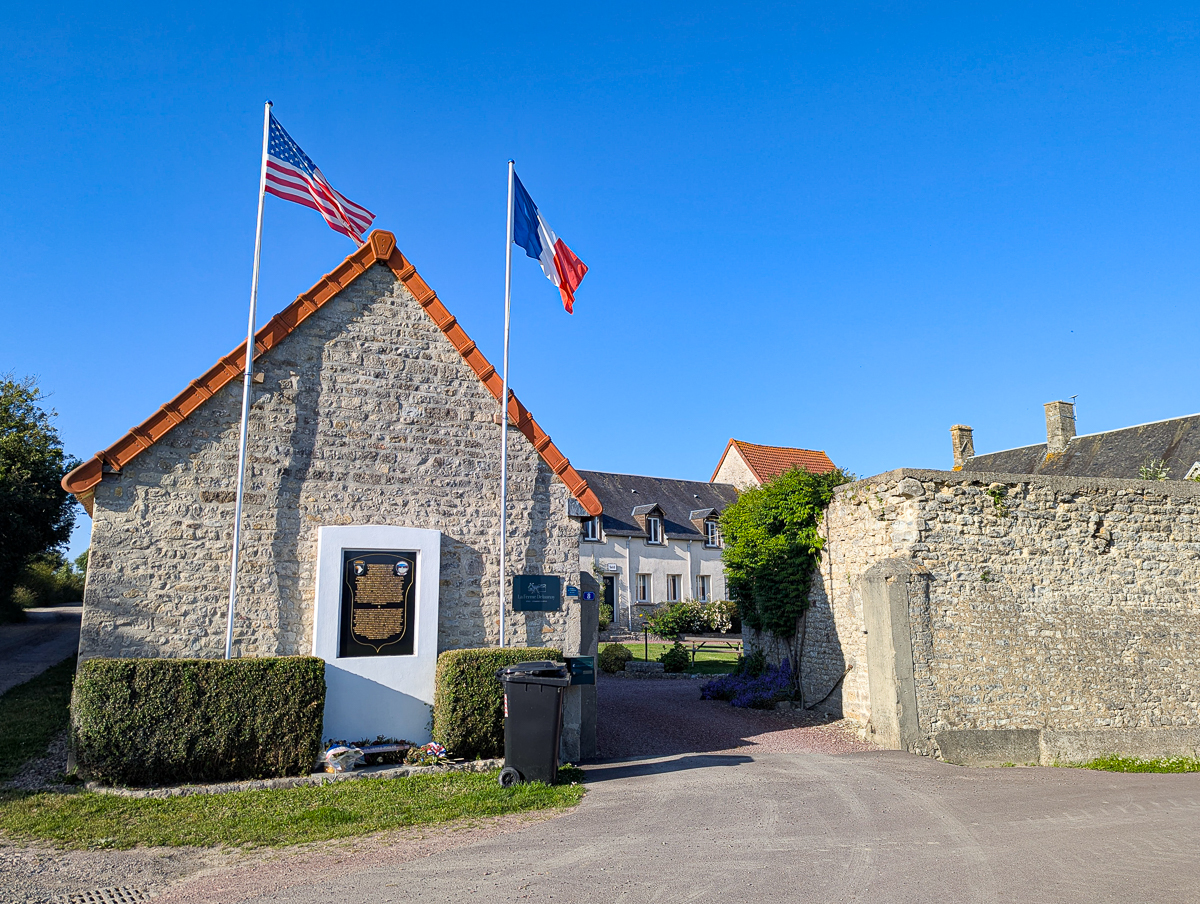
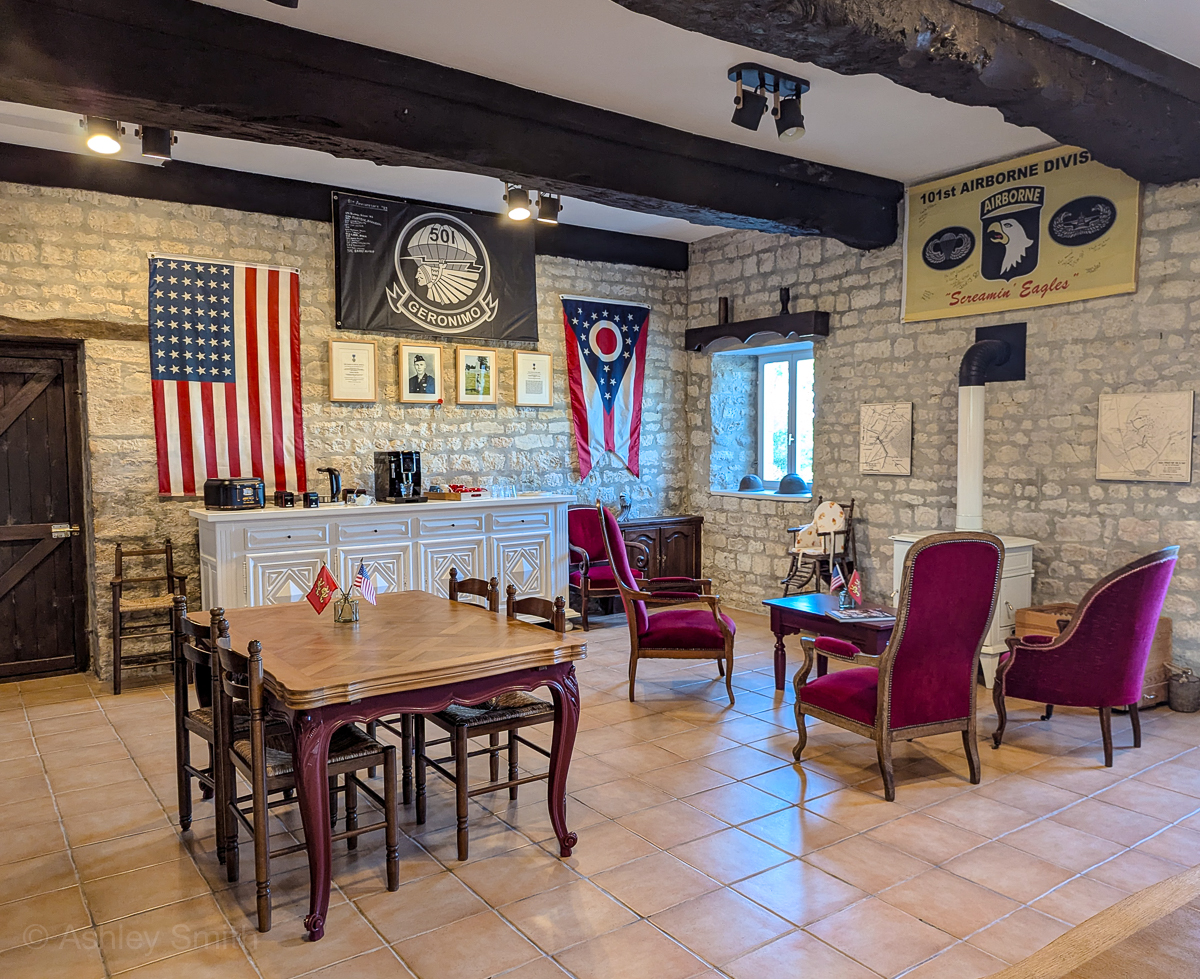
Le Grand Hard (Sainte-Marie-du-Mont)
One of the most interesting places to stay in Normandy near Utah Beach is Le Grand Hard, a renovated 17th-century farm-turned-hotel. In case you were wondering, you can even bring your own horse to this hotel. It has a 9/10 rating on Booking.com – one of the highest in the area.
Le Grand Hard has beautiful rooms on a gorgeous property and serves meat from their organic farms at their restaurants. When searching for what to see at Utah Beach, don’t forget to find a hotel that’s at the center of it all. Le Grand Hard is located in Sainte-Marie-du-Mont and close to all the best things to do in Utah Beach.
Book your stay here: Le Grand Hard
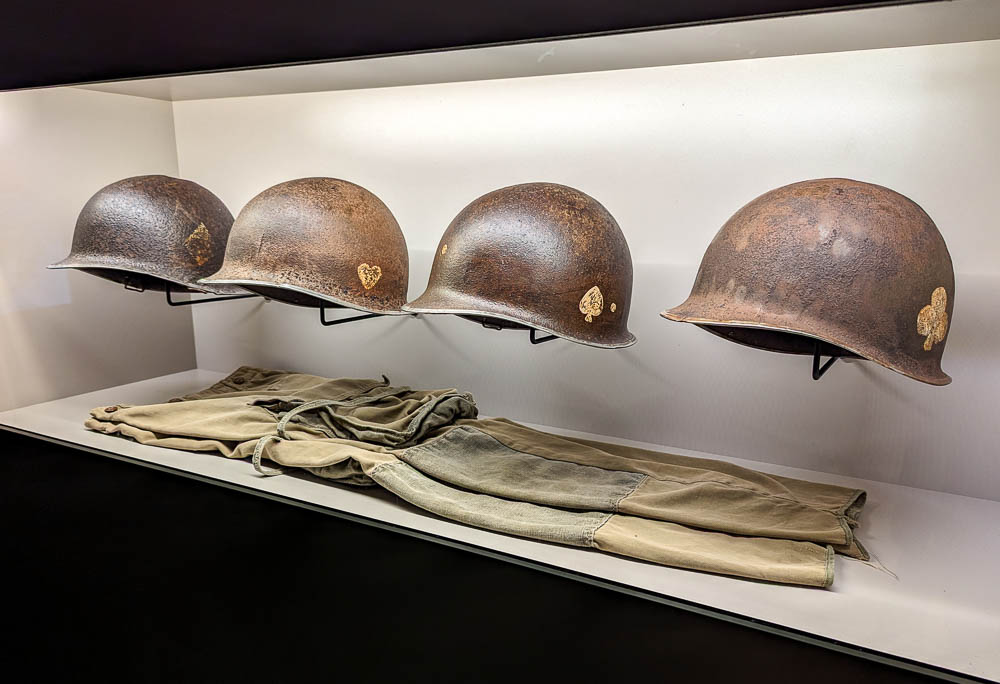
Ferme de Beauvais (Sainte-Mère-Église)
Another lodging option located in an old farmhouse is the Ferme de Beauvais in Sainte-Mère-Église. This beautiful bed and breakfast is just a 13-minute walk from the Airborne Museum and the church of Sainte-Mère-Église.
It features free Wi-Fi and private parking, a garden and terrace, and reviewers absolutely love the hospitality here.
Book your stay here: Ferme de Beauvais
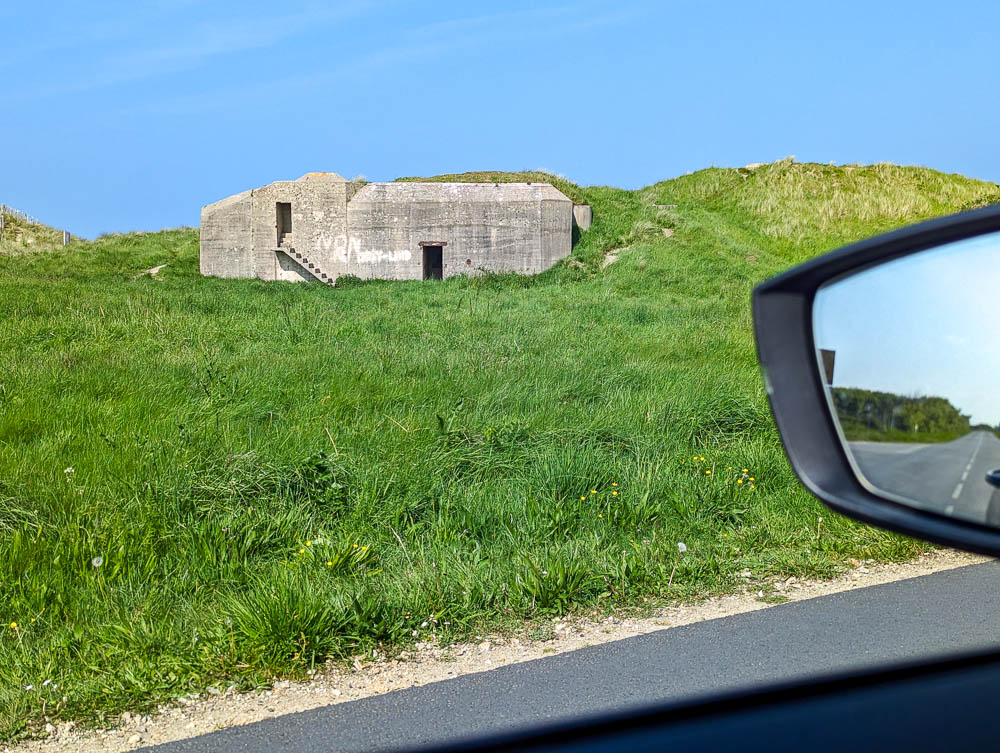
More info for your visit to Utah Beach, Normandy
- Hotels: Find great places to stay near Utah Beach here on Booking.com (but Expedia and Hotels.com often have similar deals too). VRBO is great for rental properties.
- Rental cars: Check out the best local car rental deals here.
- Travel planning: Pick up a Normandy guidebook and this must-have France customs and culture guide.
- For Normandy tours: Check out the best local options and the best day tours from Paris here.
- Be sure to watch Saving Private Ryan, The Longest Day, and Band of Brothers before your visit!
- What else have I covered in France? Check out my France archives.
Like this post? Have questions about visiting Utah Beach? Let me know in the comments below. Have a great time in Normandy!

Save this info, pin this image:
